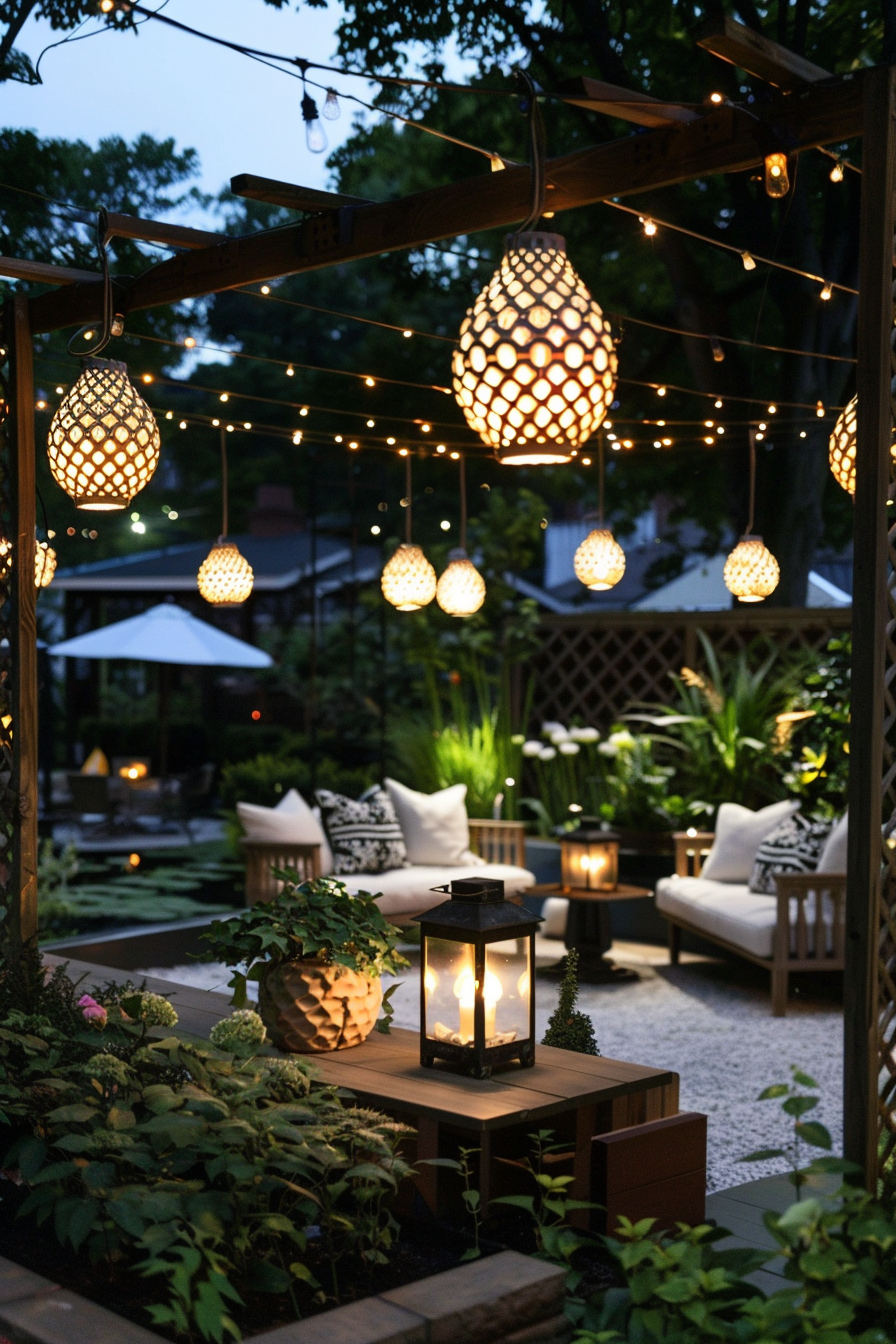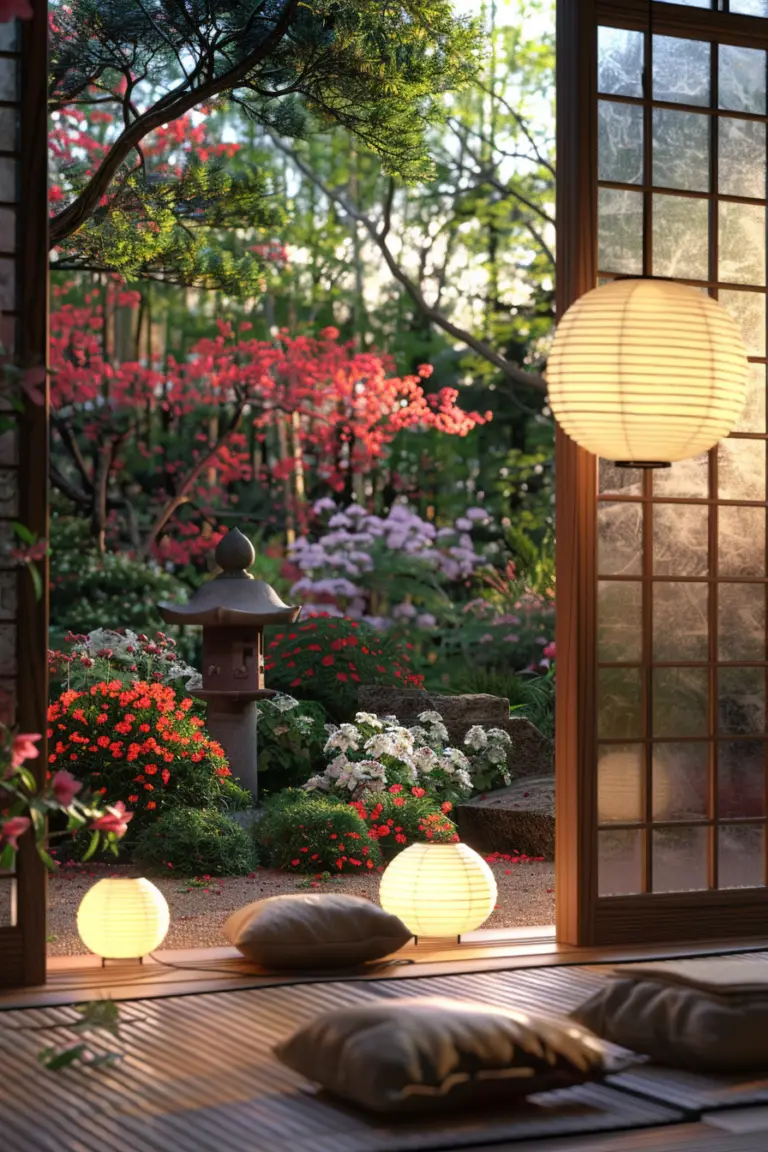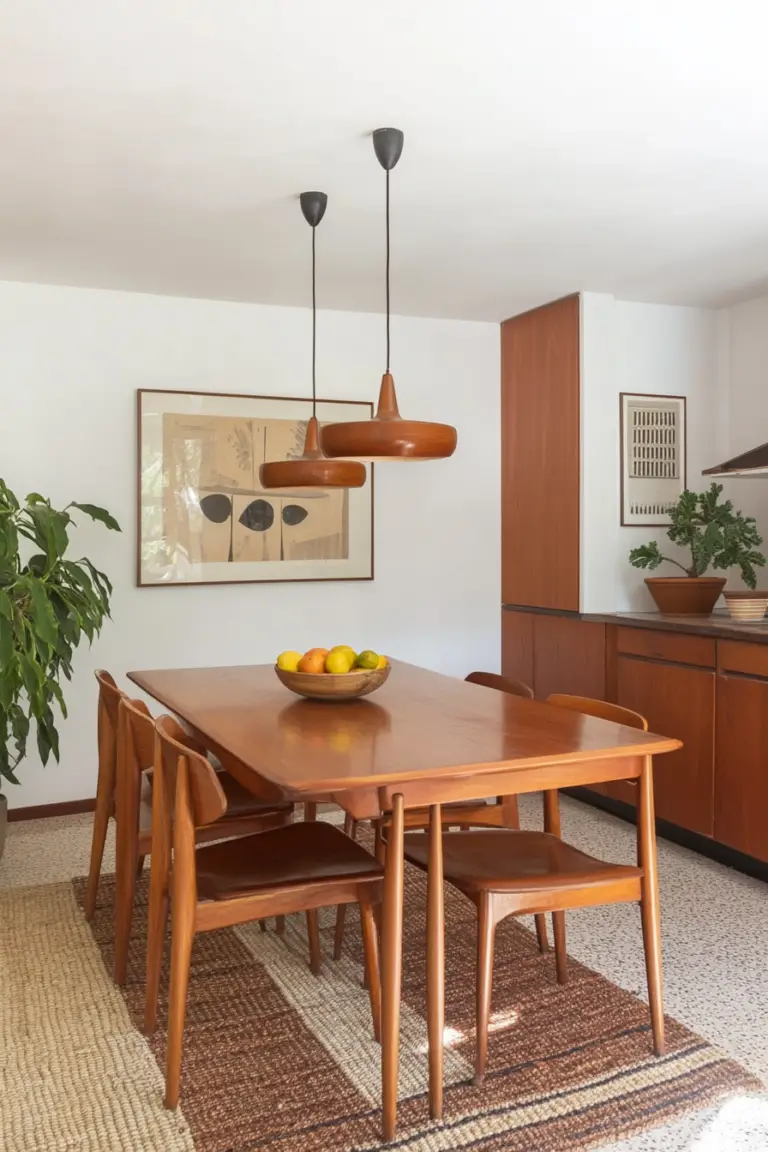How to Start Your DIY Backyard Landscaping Makeover
Did you know that with a bit of creativity (and some elbow grease), you can transform your backyard into a stunning retreat without hiring a pricey landscaper? That’s right—you’ve got all it takes to give your outdoor space a fabulous facelift!
Breaking the Myth: You Don’t Need a Fortune to Transform Your Backyard
Many folks think a backyard makeover requires a hefty budget and professional help. But here’s the secret: with DIY projects and smart planning, you can create a personal oasis that reflects your style and meets your needs.
How to Start a DIY Backyard Makeover
Declutter and Clean Up
First things first—tidy up! Removing debris, trimming overgrown plants, and cleaning hard surfaces can instantly refresh your space.
- Tip: Set aside a weekend to declutter—it’s amazing what a difference a clean slate makes!
Create Cozy Zones
Think about how you want to use your backyard. Creating designated areas can make your space feel larger and more inviting.
- Relaxation Station: Set up a hammock or comfy chairs for lounging.
- Dining Delight: Arrange a simple table and chairs for outdoor meals.
- Playful Patch: Dedicate an area for games or a mini garden.
Add Greenery and Blooms
Plants bring life and color to any backyard. Plus, gardening is a rewarding (and therapeutic) hobby!
- Tip: Opt for native plants—they’re easier to care for and great for the local ecosystem.
Light It Up
Outdoor lighting can transform your backyard into a magical evening retreat.
- Tip: Use solar-powered lights (eco-friendly and cost-effective!) to illuminate pathways or highlight features.
DIY Decor and Personal Touches
Here’s where you can really let your personality shine.
- Get Crafty: Paint old pots in vibrant colors or create a mosaic stepping stone.
- Upcycle Treasures: Turn pallets into furniture or old jars into lanterns.
- Artful Additions: Hang wind chimes or outdoor art pieces to add charm.
Budget-Friendly Tips and Ideas
- Shop Smart: Visit thrift stores or garage sales for unique and affordable finds.
- Grow from Seeds: Starting plants from seeds is cheaper and gives you a wider variety.
- DIY Everything: From building planters to creating your own compost, doing it yourself saves money and adds a personal touch.
Quick Tips to Pull It All Together
- Plan Ahead: Sketch out your ideas to visualize the final look.
- Start Small: Tackle one project at a time to avoid feeling overwhelmed.
- Mix and Match: Combine different textures and materials for an eclectic vibe.
- Invite Nature In: Incorporate bird feeders or butterfly-friendly plants.
- Enjoy the Process: Remember, it’s your space—make it a fun and fulfilling journey!
1. Maximize Small Plots with Vertical Gardening
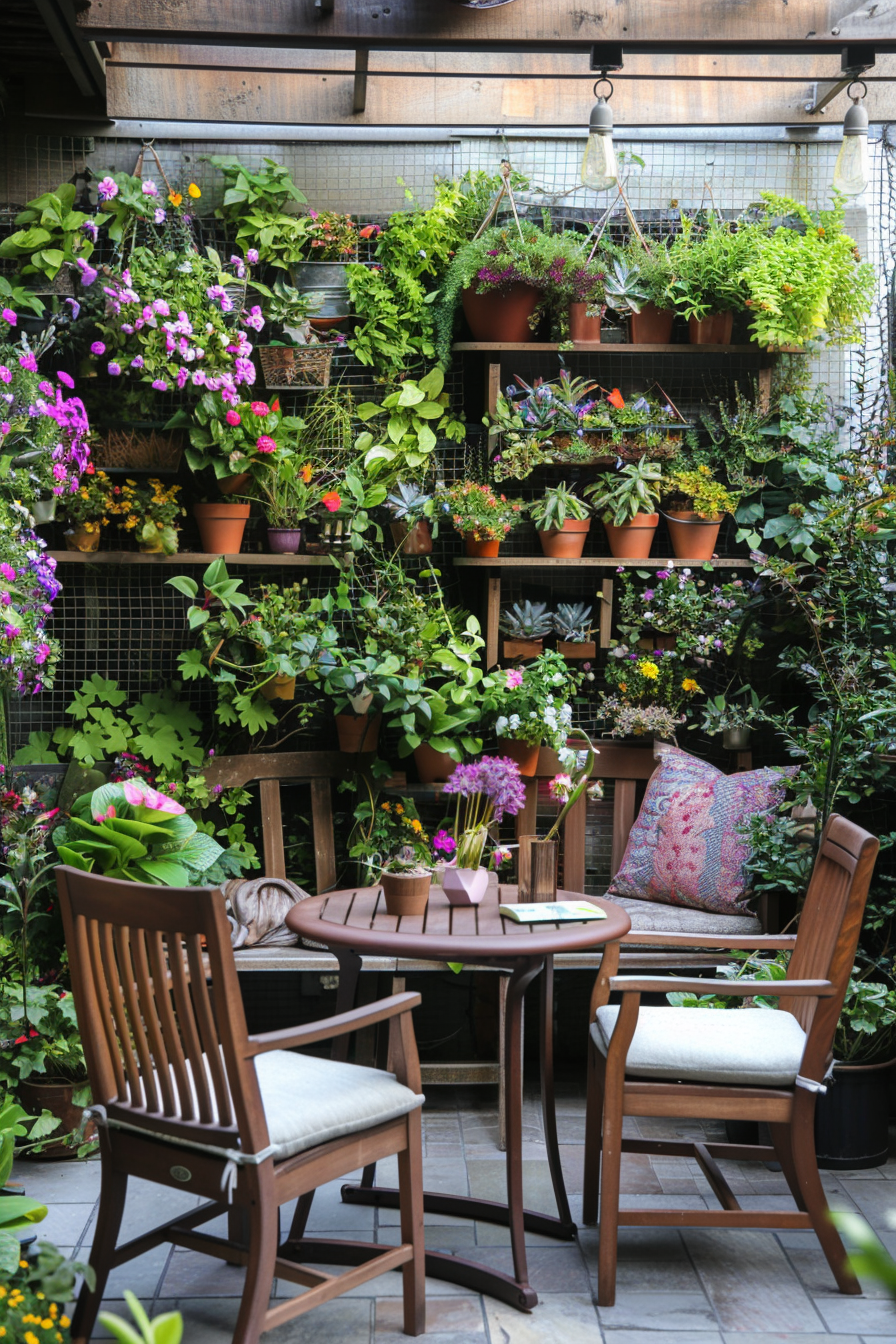
When space is at a premium, think vertically! Vertical gardening allows you to grow plants upwards, making the most of limited ground area. This method is especially effective for small backyards where traditional horizontal planting might not be feasible. By using structures like wall-mounted planters, hanging baskets, or trellises, you can create lush, green walls that bring vibrancy and life to your outdoor space. These vertical elements not only maximize your growing area but also add visual interest and texture.
A variety of plants can be used to create a dynamic and engaging vertical garden. Consider a mix of herbs, flowers, and foliage plants to introduce different colors, shapes, and scents. Succulents, ferns, and trailing ivy are popular choices for vertical gardens due to their hardy nature and appealing aesthetics. You can also incorporate seasonal flowers to add bursts of color that change throughout the year, keeping your garden looking fresh and vibrant.
Maintenance is key to keeping a vertical garden thriving. Ensure that each plant receives adequate sunlight, water, and nutrients. Drip irrigation systems or self-watering planters can be particularly useful for vertical gardens, as they simplify watering and help maintain consistent moisture levels. With thoughtful planning and care, a small plot can be transformed into a lush, green oasis that defies its size constraints.
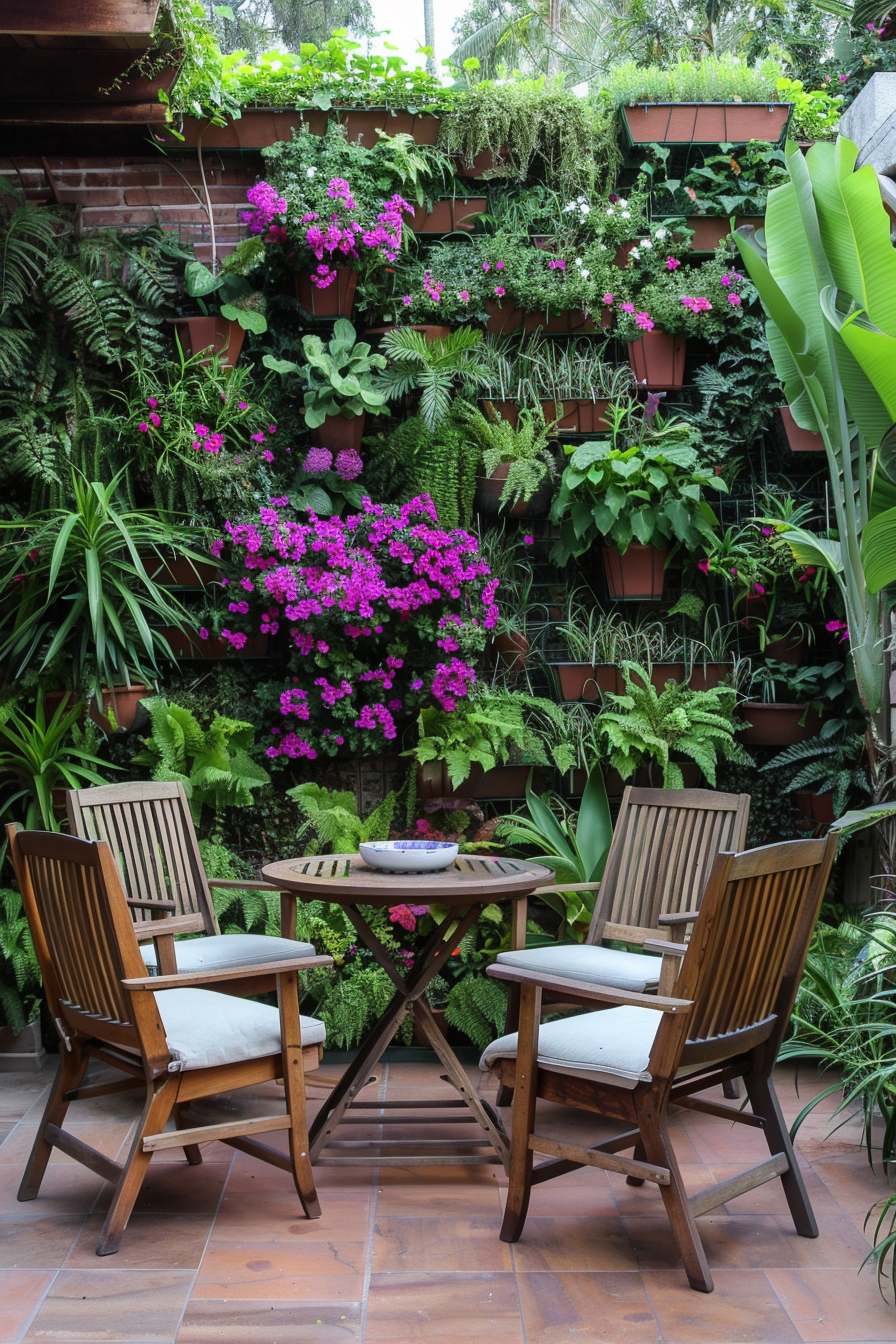
2. Design a Cozy Corner in Large Plots
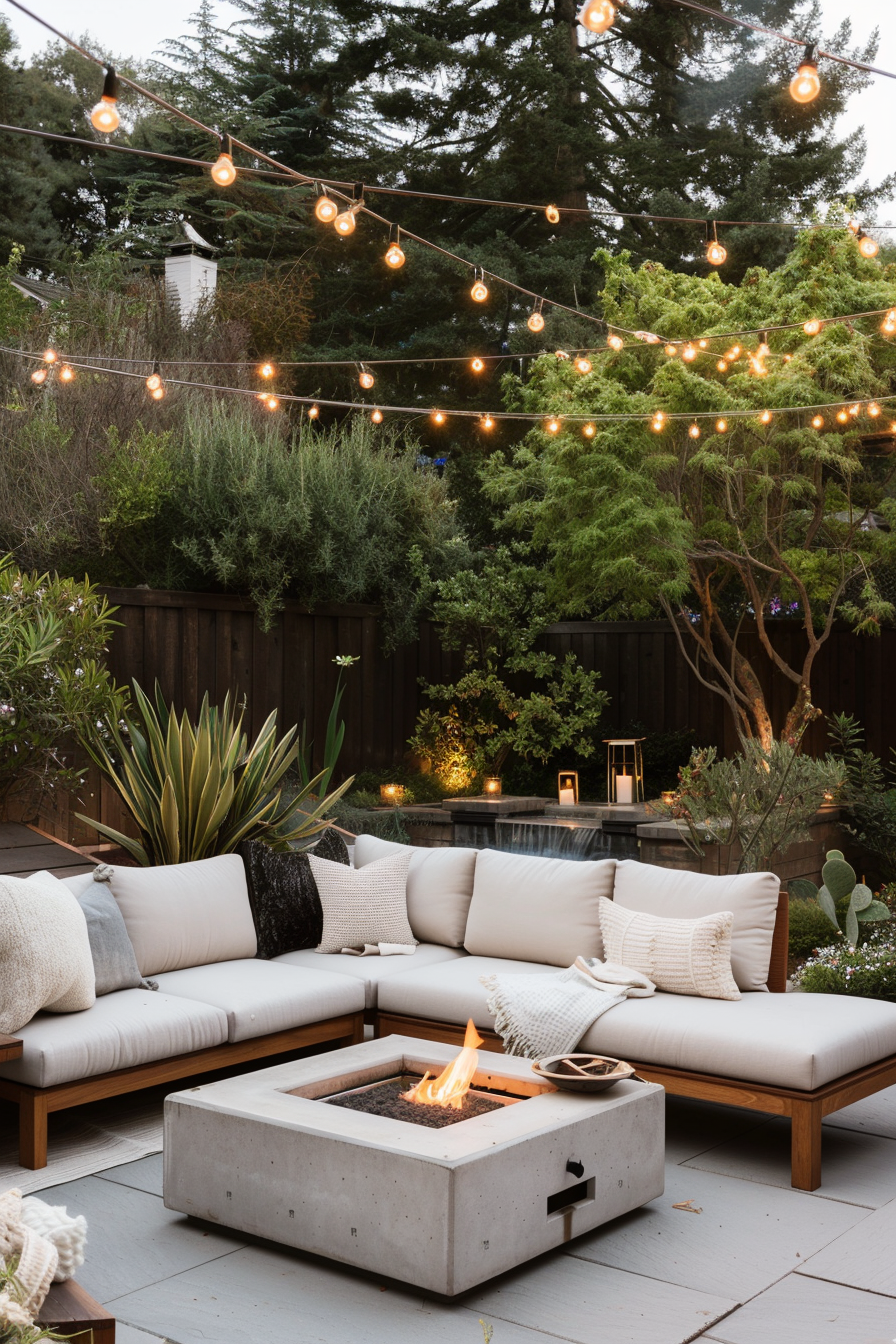
For those blessed with a large backyard, creating a cozy corner can turn an expansive area into a warm and inviting retreat. Start by choosing a secluded spot that naturally offers some privacy, such as a corner bordered by trees or shrubs. This area can be the perfect place to unwind, read a book, or enjoy a cup of coffee. Outfit this nook with comfortable outdoor furniture like cushioned chairs, a loveseat, or even a hammock to create a relaxed seating area.
Lighting plays a crucial role in setting the mood for your cozy corner. String lights can add a magical touch, creating a canopy of twinkling stars above your head. Solar-powered lanterns or candles can provide soft, ambient lighting that enhances the evening atmosphere. Consider adding a fire pit or a chiminea to provide warmth on cooler nights and serve as a focal point for gatherings. The flickering flames and the crackle of wood burning add to the cozy, inviting feel.
Soft textiles such as throw blankets and outdoor pillows can further enhance the comfort and charm of your cozy corner. Choose weather-resistant fabrics in warm, inviting colors and patterns that complement your overall outdoor décor. Adding a few potted plants or a small water feature nearby can also contribute to a peaceful, serene environment. Whether you’re hosting a small gathering or enjoying some quiet time alone, a cozy corner can make your large backyard feel more intimate and welcoming.
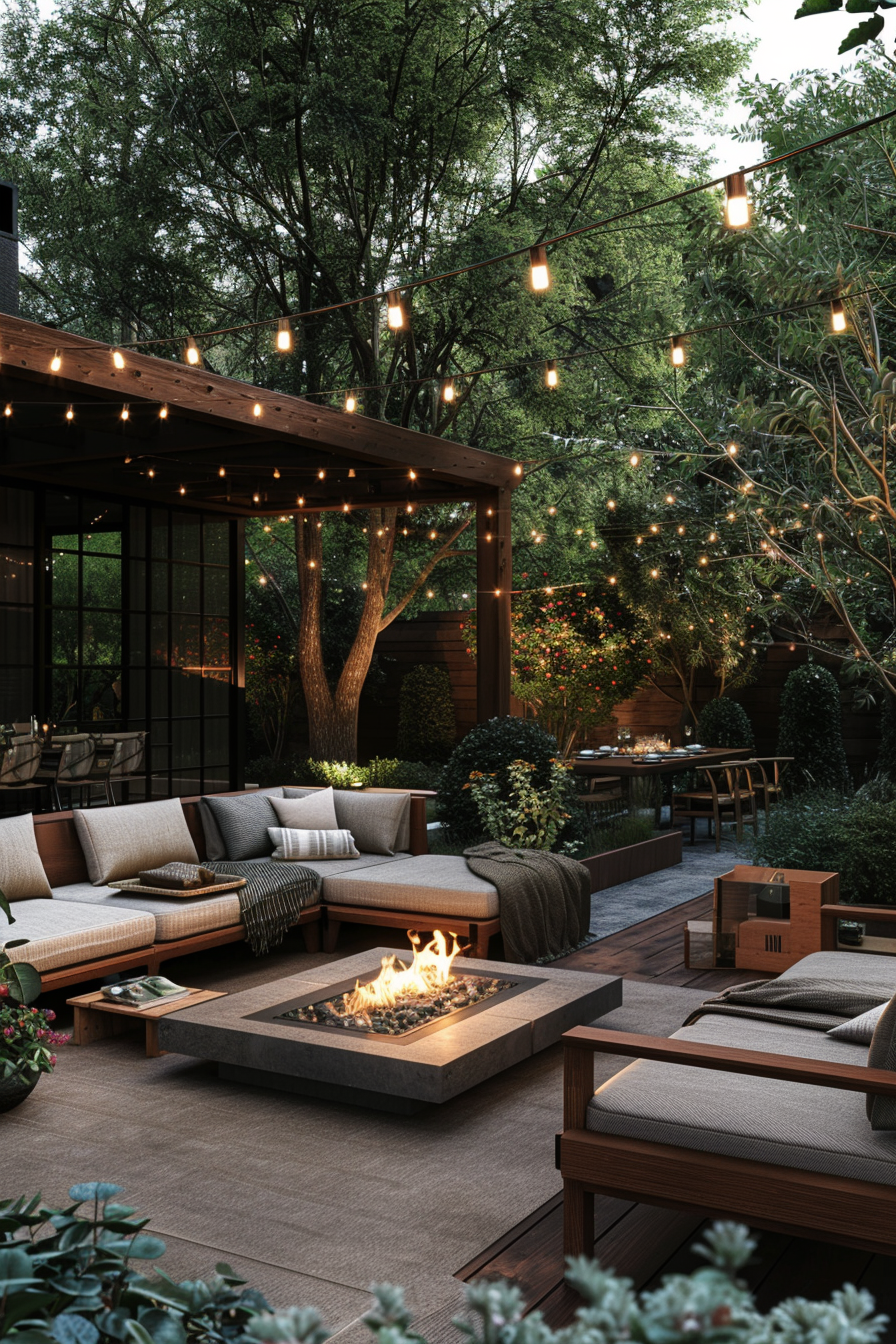
3. Embrace Modern Minimalism

Modern backyard design is all about simplicity and elegance. Clean lines, sleek materials, and a minimalist aesthetic define this style. To achieve this look, focus on using contemporary materials such as concrete, metal, and glass. These elements can be incorporated into various aspects of your backyard, from patios and pathways to furniture and water features. The result is a cohesive, sophisticated outdoor space that feels both stylish and functional.
Geometric shapes are a hallmark of modern design. Consider incorporating these shapes into your landscaping through features like square or rectangular pavers, straight-edged planters, or a linear water feature. A simple, uncluttered layout with clear boundaries and open spaces helps maintain the clean, modern look. Select a neutral color palette dominated by shades of grey, black, and white, and add subtle pops of color through plants or accent pieces.
Plants play an essential role in adding life and softness to a modern backyard. Opt for a few carefully chosen plant species that complement the overall design. Succulents, ornamental grasses, and architectural plants like agaves or yuccas are excellent choices. These plants often require less maintenance and fit well with the minimalist ethos. By combining these elements thoughtfully, you can create a modern backyard that is both beautiful and easy to maintain.
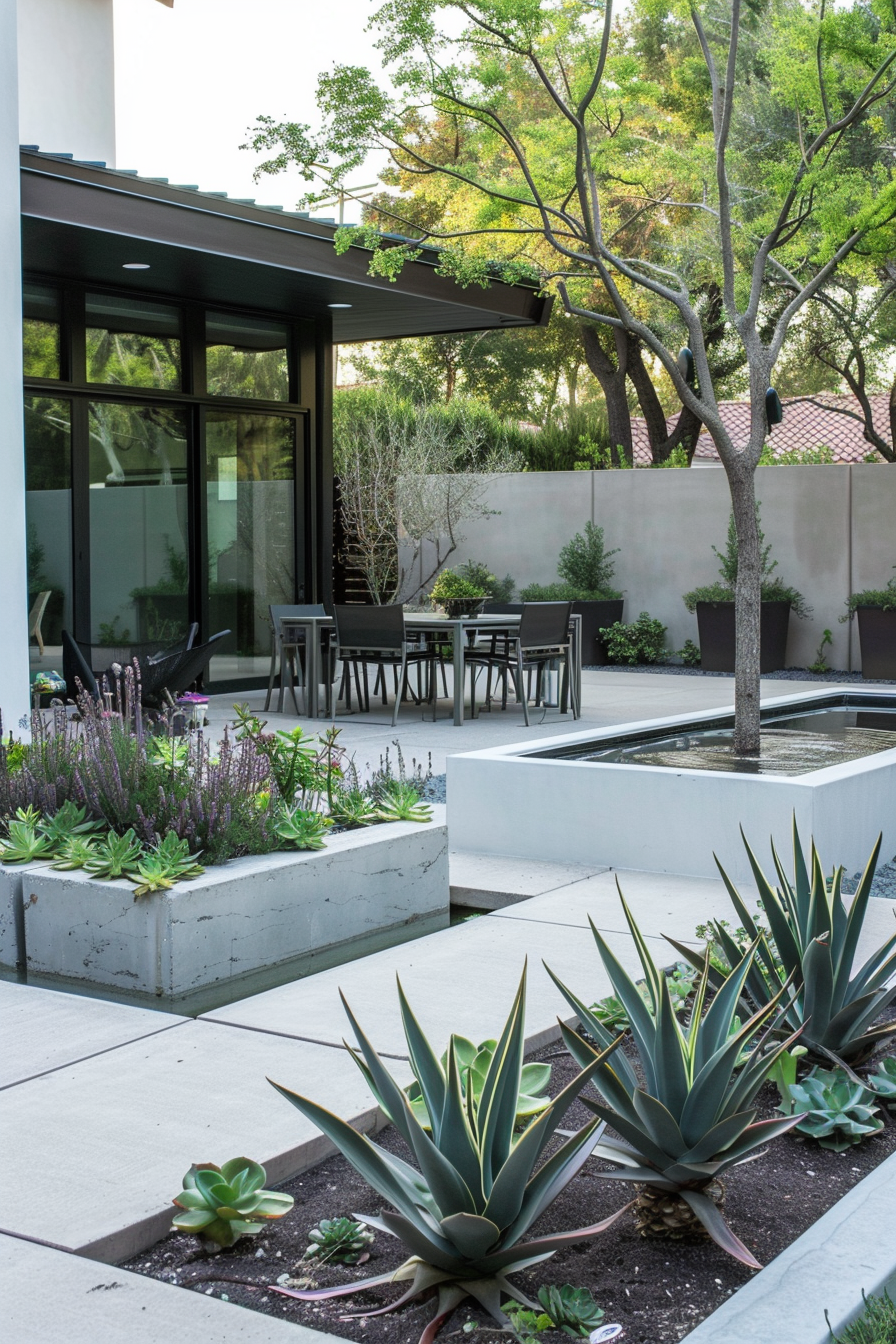
4. Keep It Simple with Low-Maintenance Plants
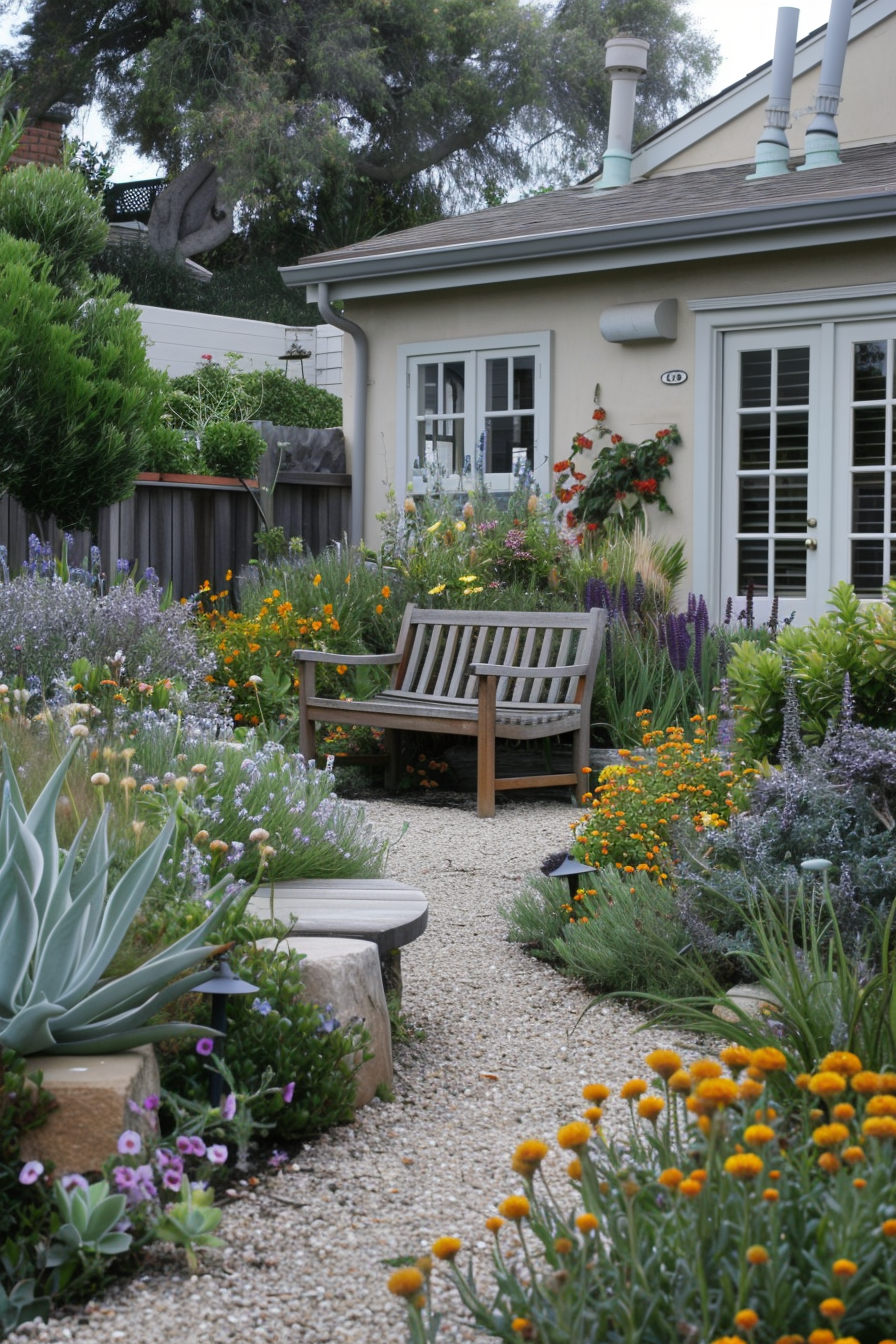
Simplifying your backyard doesn’t mean sacrificing beauty. By choosing low-maintenance plants, you can create a stunning garden that requires minimal effort to upkeep. Start with succulents, which come in a variety of shapes, colors, and sizes. These hardy plants are drought-tolerant and thrive in various conditions, making them perfect for busy homeowners who want a beautiful garden without the hassle.
Ornamental grasses are another excellent choice for a low-maintenance backyard. These grasses add movement and texture to your garden, swaying gently with the breeze. Species like feather reed grass, fountain grass, and blue oat grass require little water and care once established. Their tall, arching forms provide visual interest and can be used to create natural screens or borders in your garden.
Perennial flowers, such as lavender, coneflowers, and daylilies, bring vibrant color and fragrance to your backyard year after year. Unlike annuals, which need to be replanted each season, perennials come back on their own, reducing the amount of work required to maintain a beautiful garden. By combining succulents, ornamental grasses, and perennials, you can enjoy a diverse, attractive backyard that’s as low-maintenance as it is lovely.
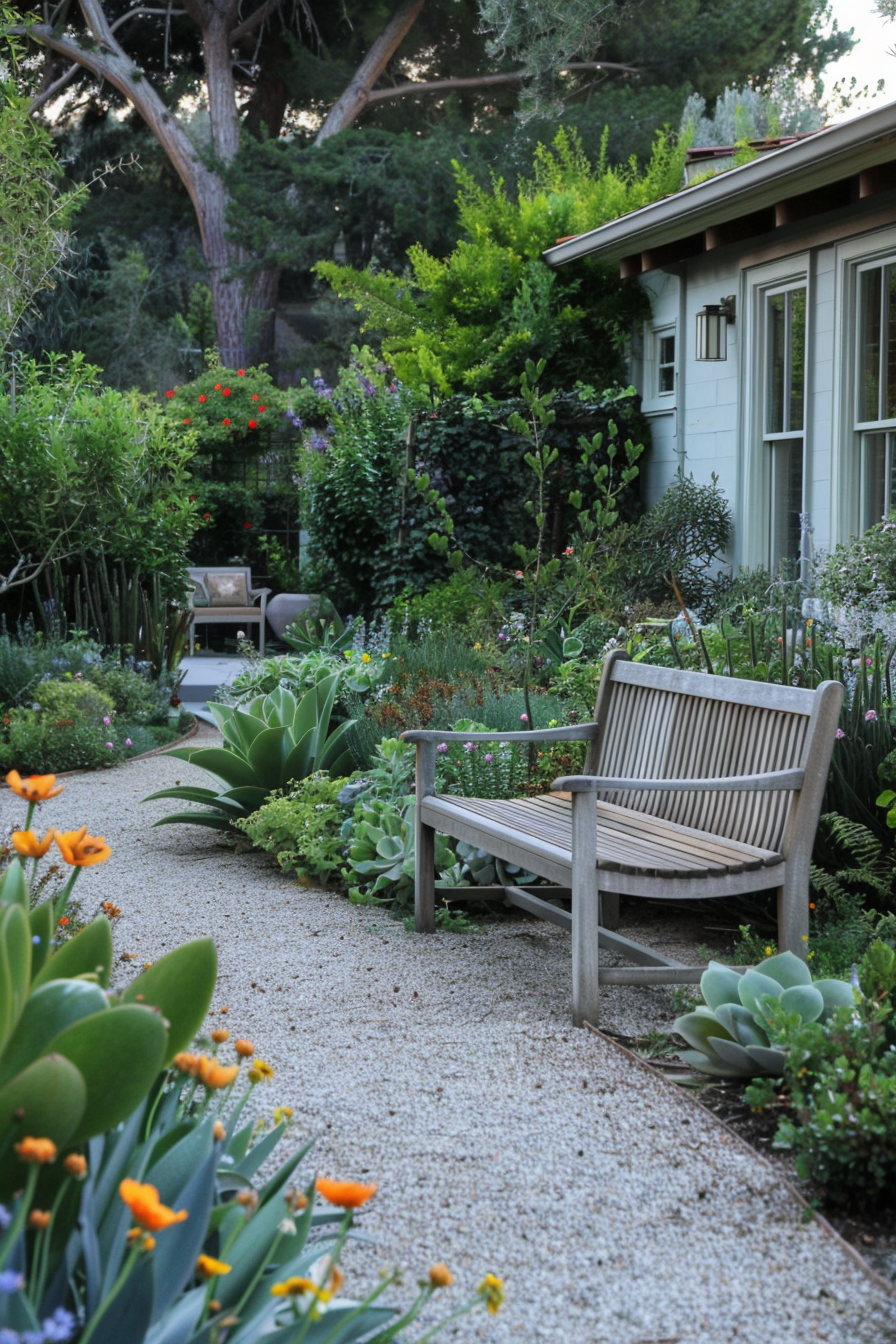
5. Tackle Sloped Plots with Terraced Gardens
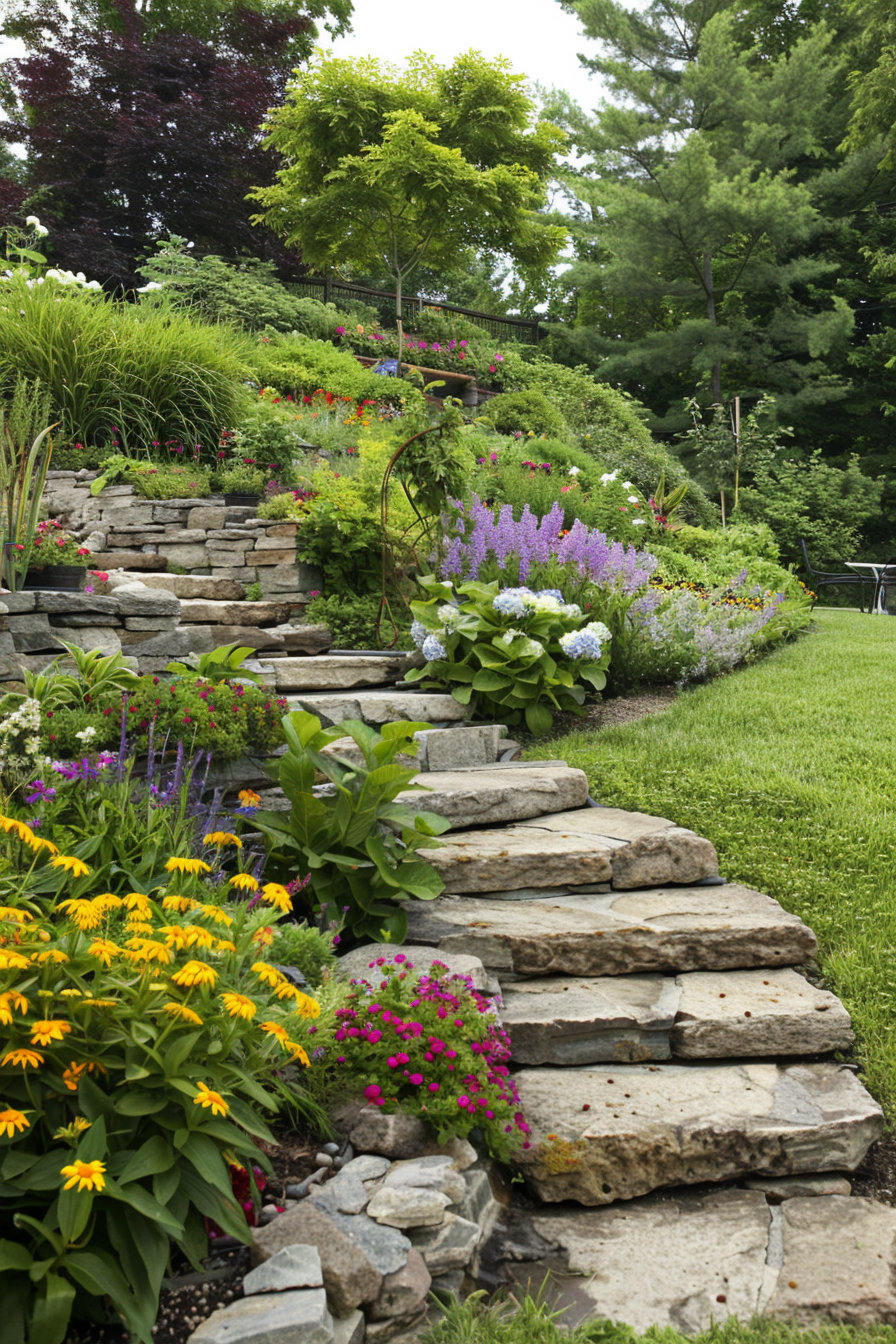
Sloped backyards can be challenging, but they also offer unique opportunities for creative landscaping. One effective solution is to create terraced gardens, which involve building retaining walls to form flat planting areas at different levels. These terraces help manage erosion and water runoff, making the sloped land more usable. Using materials like stone, brick, or wood for the retaining walls adds a natural, sturdy element to the design.
Each terrace can be planted with different types of plants, creating a layered effect that adds depth and visual interest. Lower terraces can be reserved for ground cover and small plants, while middle and upper levels can feature shrubs, flowers, or even small trees. This multi-level planting approach not only makes the most of the vertical space but also helps to create a sense of scale and proportion in the garden.
Terraced gardens are perfect for incorporating additional features like water elements or pathways. A cascading waterfall can add a dynamic and soothing focal point, while stone steps can provide a functional and aesthetic way to navigate between the levels. Lighting can be strategically placed to highlight the terraces and create a dramatic effect at night. By embracing the slope and using terraces to your advantage, you can transform a challenging plot into a beautiful, tiered garden paradise.
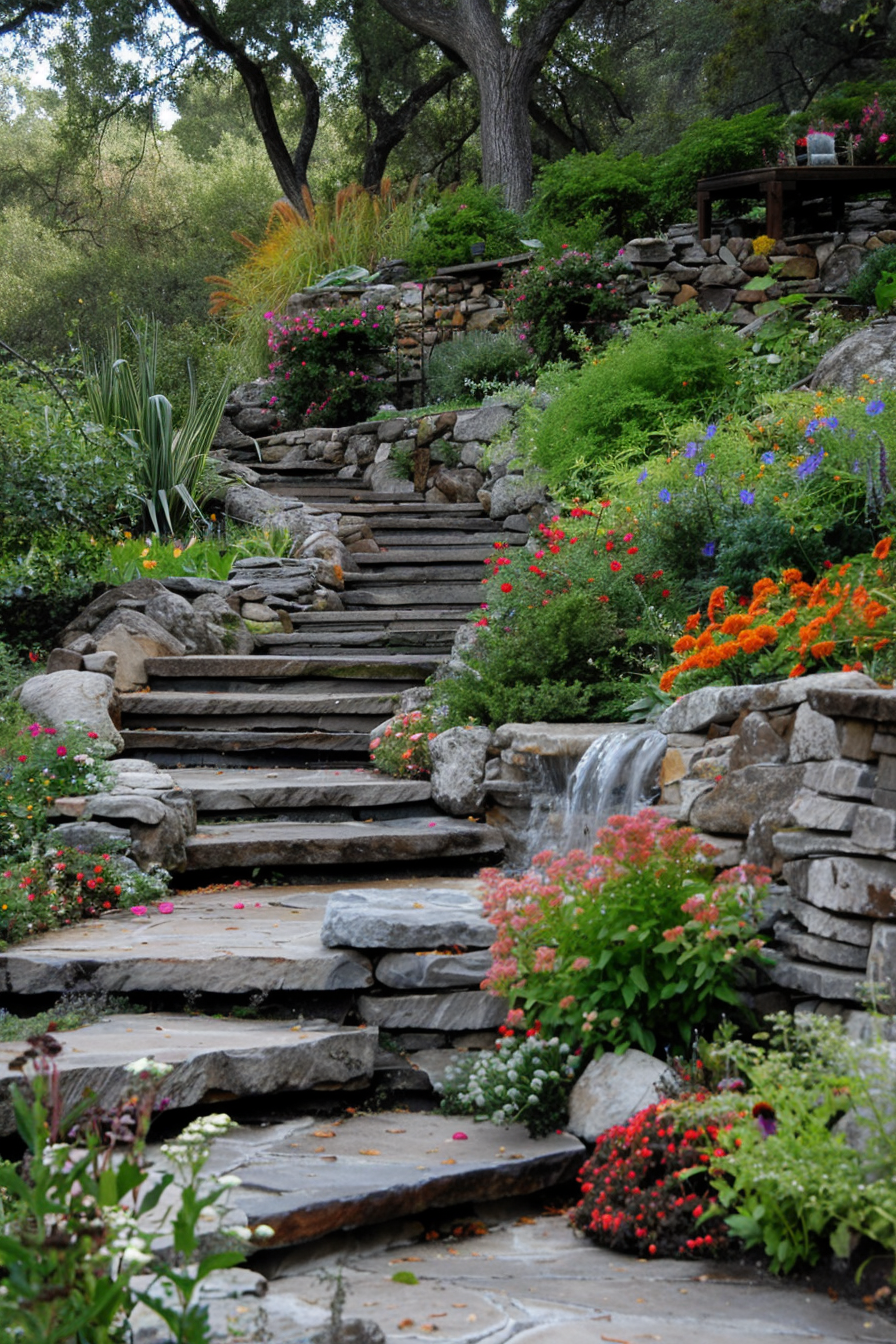
6. Create a Natural Haven in Wooded Areas
If you have a wooded backyard, you have the perfect setting to create a natural haven that blends seamlessly with the existing landscape. Start by embracing the native plants and trees that thrive in your area. These plants are well-suited to the local climate and soil conditions, making them easier to care for and more likely to flourish. Native ferns, wildflowers, and shrubs can enhance the woodland feel and attract local wildlife.
Incorporate natural materials like wood, stone, and mulch to maintain the rustic, organic aesthetic. Use large stones or logs to create seating areas or borders for garden beds. A winding stone path can guide visitors through the woods, encouraging exploration and connection with nature. Mulch pathways and garden beds not only help with moisture retention and weed control but also add to the natural look of the space.
To further enhance the serene atmosphere, consider adding a few carefully placed features like a small pond, a trickling fountain, or a simple wooden bench. These elements provide focal points and invite quiet reflection. By carefully planning and preserving the natural beauty of a wooded backyard, you can create a peaceful retreat that feels both wild and welcoming.
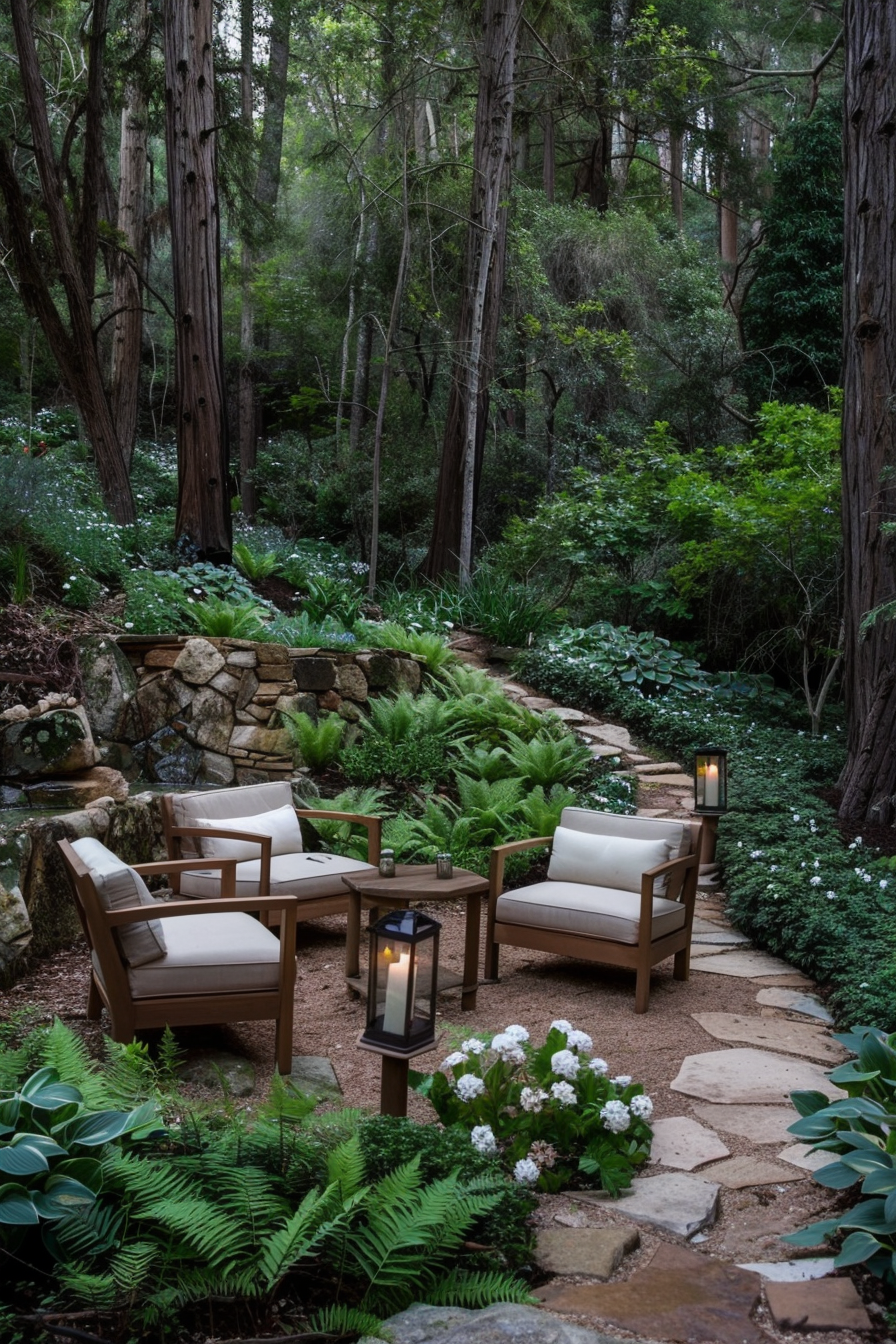
7. Bring a Tropical Vibe with Lush Foliage
Transforming your backyard into a tropical paradise is all about creating a lush, vibrant environment filled with exotic plants and lively colors. Start by planting a variety of tropical species such as palms, hibiscus, bird-of-paradise, and bromeliads. These plants thrive in warm, humid conditions and bring the rich textures and bold hues typical of tropical landscapes. Arrange them in dense clusters to mimic the look of a tropical rainforest.
To enhance the tropical vibe, incorporate elements like bamboo fencing, tiki torches, and thatched-roof structures. These features not only provide a sense of privacy but also add to the exotic, island feel of your backyard. Consider adding a hammock or a hanging chair to create a relaxing spot where you can enjoy the shade and gentle breezes. Brightly colored cushions and outdoor decor can further elevate the tropical atmosphere.
Water features are a must-have in a tropical-themed backyard. A small pond, waterfall, or even a simple bubbling fountain can introduce the soothing sounds of water, enhancing the sense of tranquility. Surround the water feature with large-leafed plants and rocks to integrate it naturally into the landscape. With these elements, your backyard can become a lush, tropical retreat where you can escape and unwind.
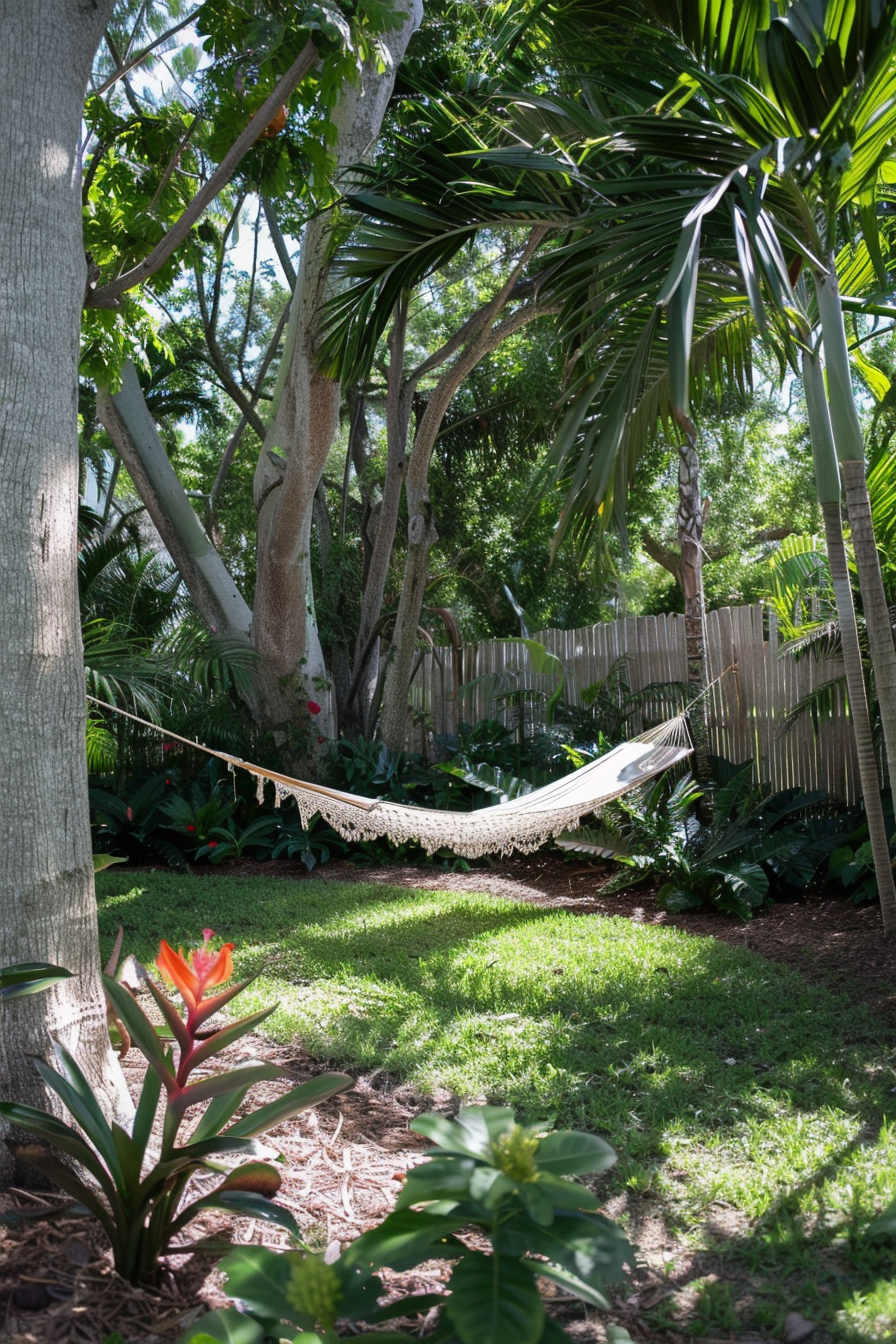
8. Install a Stylish Pergola
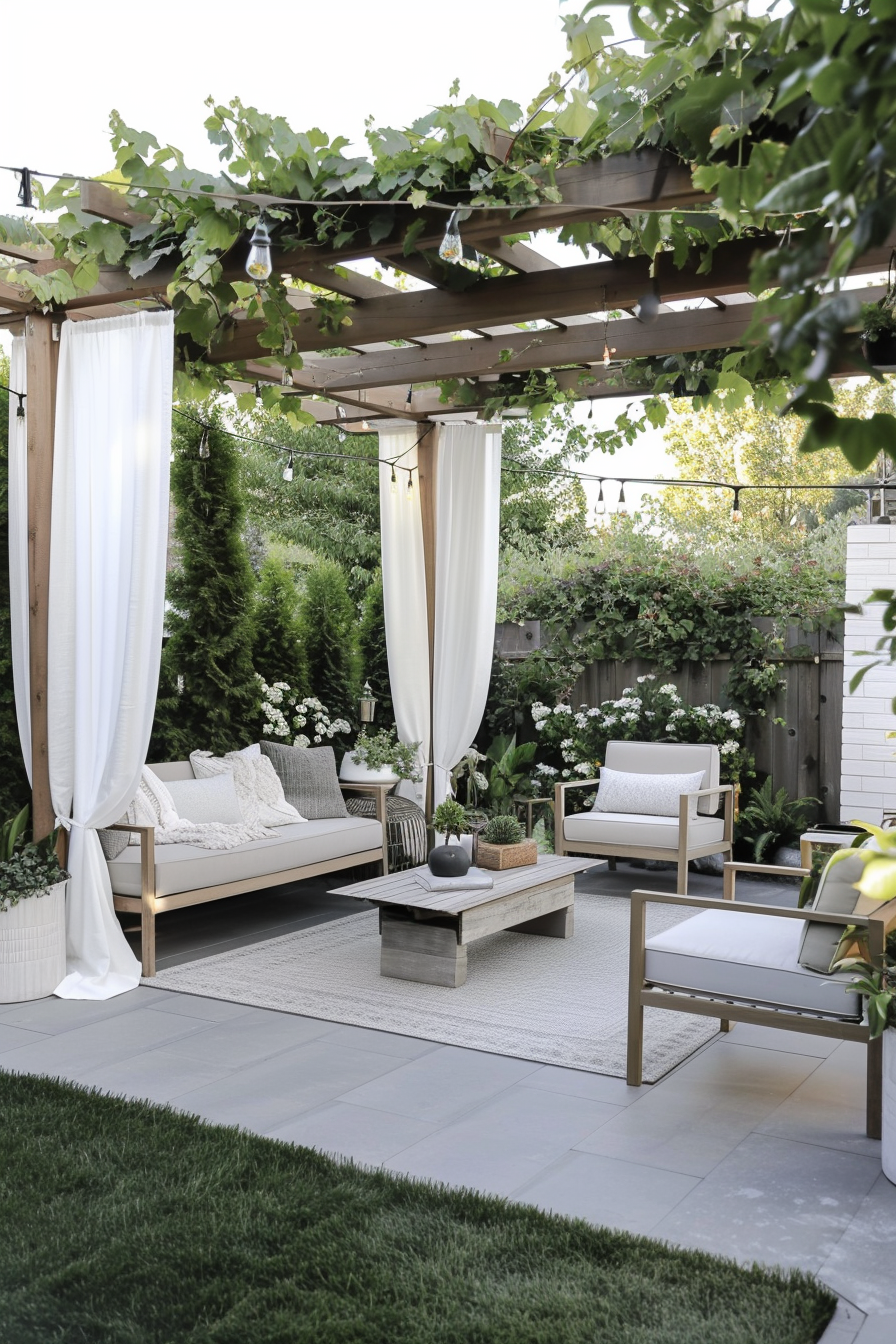
A pergola can be a fantastic addition to any backyard, providing both style and function. This versatile structure can define a space, provide shade, and support climbing plants, making it a focal point in your outdoor area. Choose a design that complements your backyard’s style—whether it’s modern with clean lines and a neutral color palette or rustic with natural wood and a classic design.
Once you have your pergola installed, think about how to dress it up. Climbing plants such as wisteria, grapevines, or roses can be trained to grow over the pergola, creating a lush, green canopy that offers both beauty and shade. Adding string lights or lanterns can enhance the ambiance, making the space perfect for evening gatherings. Fabric drapes can also be hung from the pergola to add a touch of elegance and provide additional shade and privacy.
Underneath the pergola, create a cozy seating or dining area. Outdoor furniture like a table and chairs or a sectional sofa can transform the space into a perfect spot for relaxing or entertaining. Add soft cushions, outdoor rugs, and a few decorative elements to make the area inviting and comfortable. A stylish pergola can truly elevate your backyard, providing a sheltered, charming space that you’ll love to spend time in.
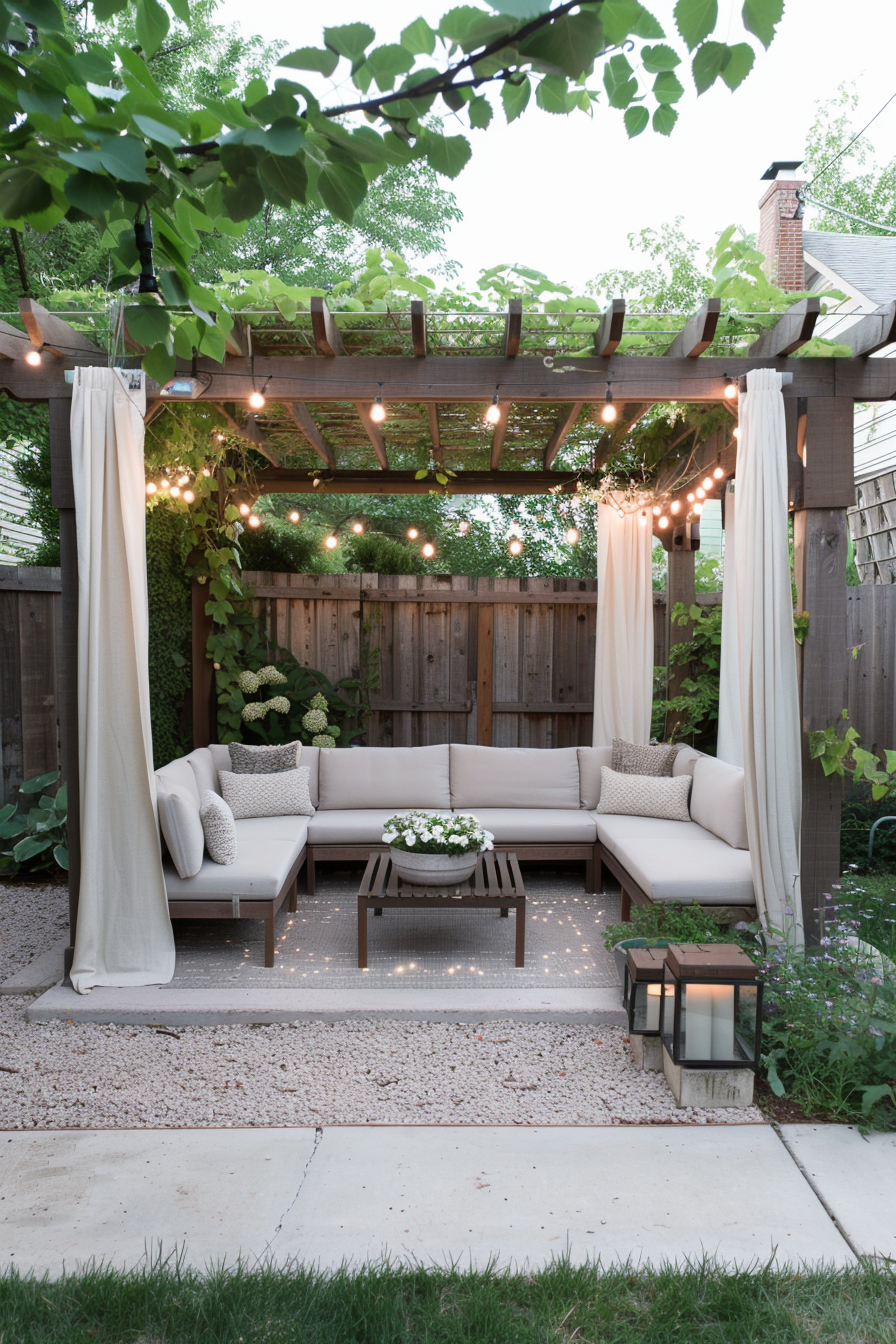
9. Incorporate Water Features for Relaxation
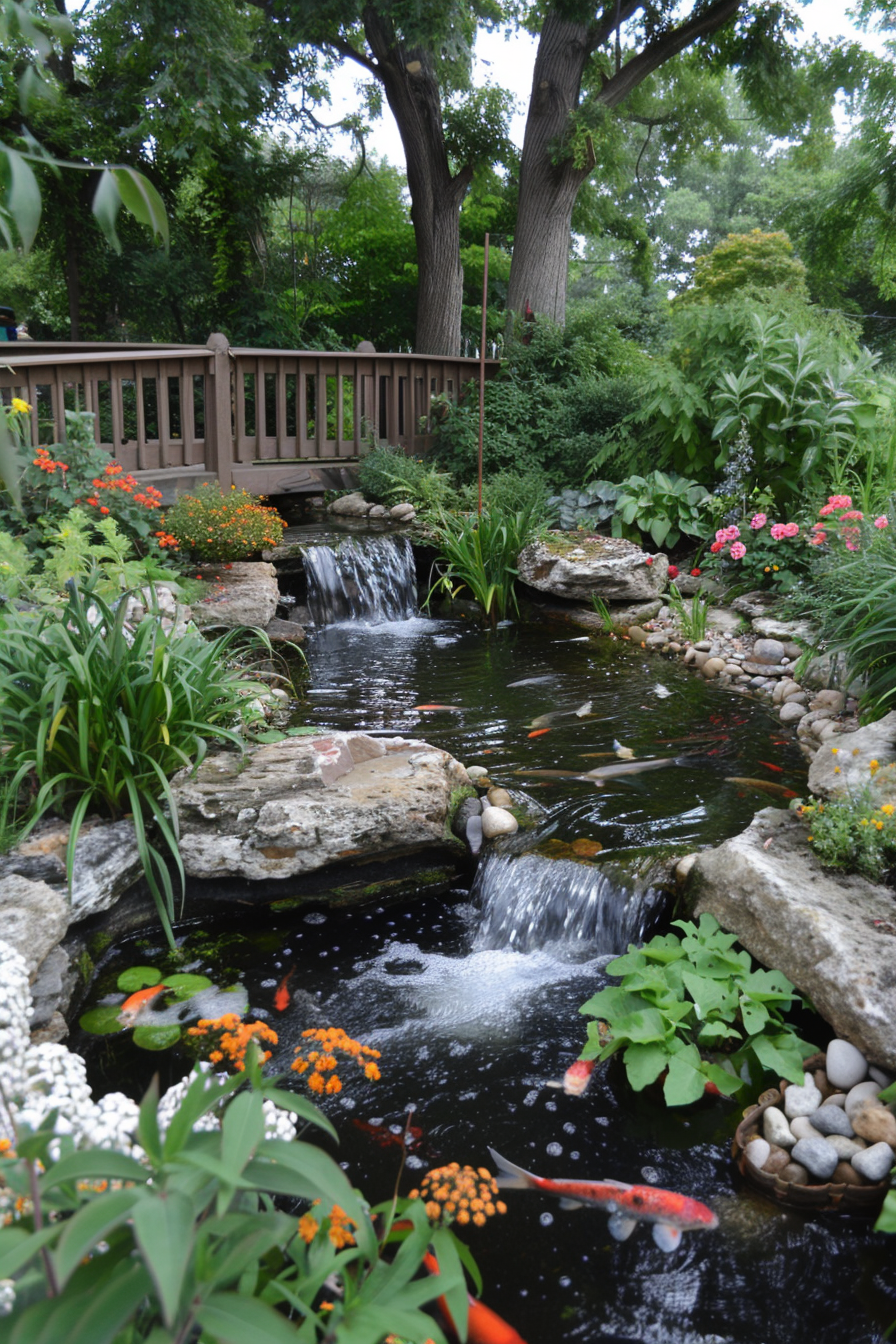
Adding a water feature to your backyard can instantly elevate its tranquility and visual appeal. Whether it’s a pond, fountain, or waterfall, the gentle sound of flowing water creates a calming atmosphere that invites relaxation. Consider the size and layout of your space when choosing a water feature; a small fountain might be perfect for a cozy corner, while a larger pond with a waterfall can become a striking focal point in a spacious yard.
Designing the area around your water feature is just as important as the feature itself. Surround it with a variety of plants and rocks to create a natural, integrated look. Aquatic plants like water lilies or lotus can thrive in ponds, while moisture-loving plants such as hostas or ferns can enhance the greenery around a fountain or waterfall. Adding some decorative elements like stones, pebbles, or even a small wooden bridge can further blend the water feature into your backyard landscape.
Lighting can also play a crucial role in showcasing your water feature, especially at night. Subtle underwater lights or spotlights can highlight the moving water and create mesmerizing reflections and shadows. Whether you choose a serene, Zen-inspired design or a more elaborate, cascading waterfall, incorporating a water feature can turn your backyard into a peaceful retreat that you can enjoy day and night.
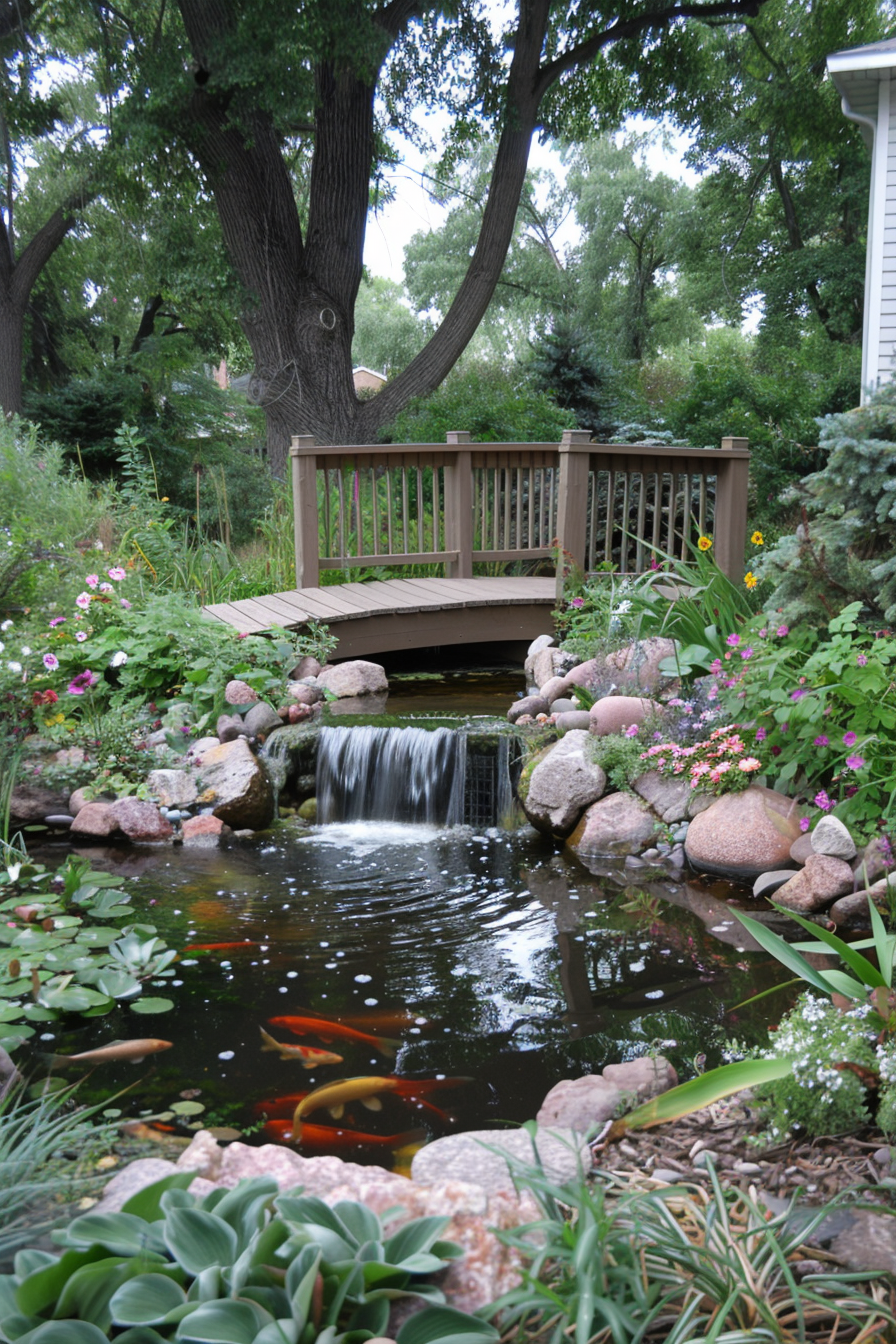
10. Design a Functional Outdoor Kitchen
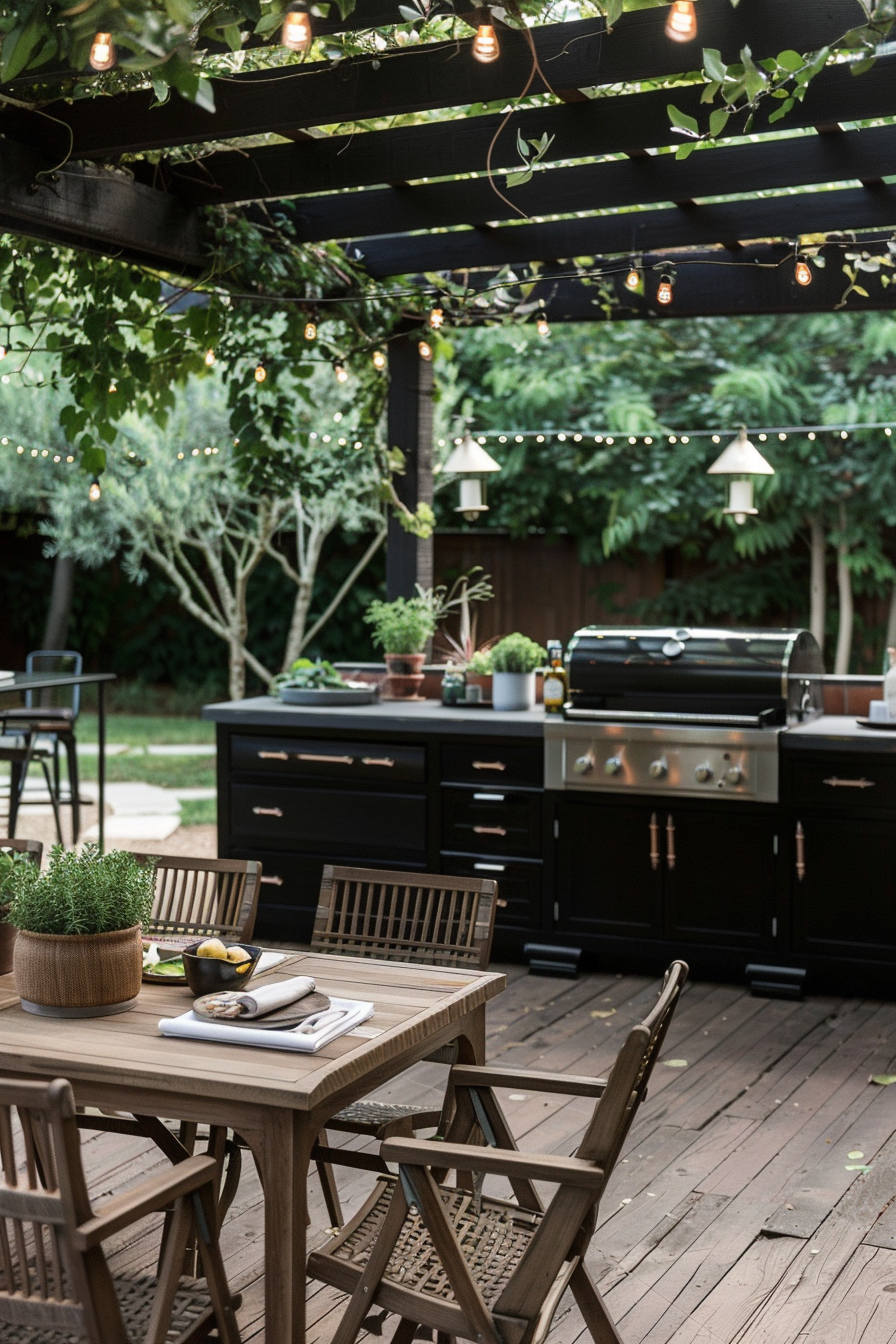
For those who love to entertain, an outdoor kitchen is a fantastic addition that can transform your backyard into a social hub. Start by selecting the right spot for your kitchen, ideally close to your house for easy access to utilities and supplies. Equip the space with essential features like a built-in grill, countertops for food preparation, and storage cabinets for cooking utensils and ingredients.
Adding a sink with running water and a small refrigerator can greatly enhance the functionality of your outdoor kitchen. These features allow you to clean and store food without having to constantly go back inside. Consider installing a durable countertop material like granite or stainless steel that can withstand the outdoor elements. Weather-resistant cabinets and drawers will help keep your kitchen organized and protect your tools from the elements.
Nearby, create a comfortable dining area where guests can relax and enjoy their meals. A large table with ample seating is perfect for family gatherings or parties. Add some shade with an umbrella or a pergola to keep the area cool during hot days. String lights or lanterns can provide ambient lighting for evening gatherings, creating a warm and inviting atmosphere. With a well-designed outdoor kitchen and dining space, your backyard can become the ultimate spot for cooking and entertaining.
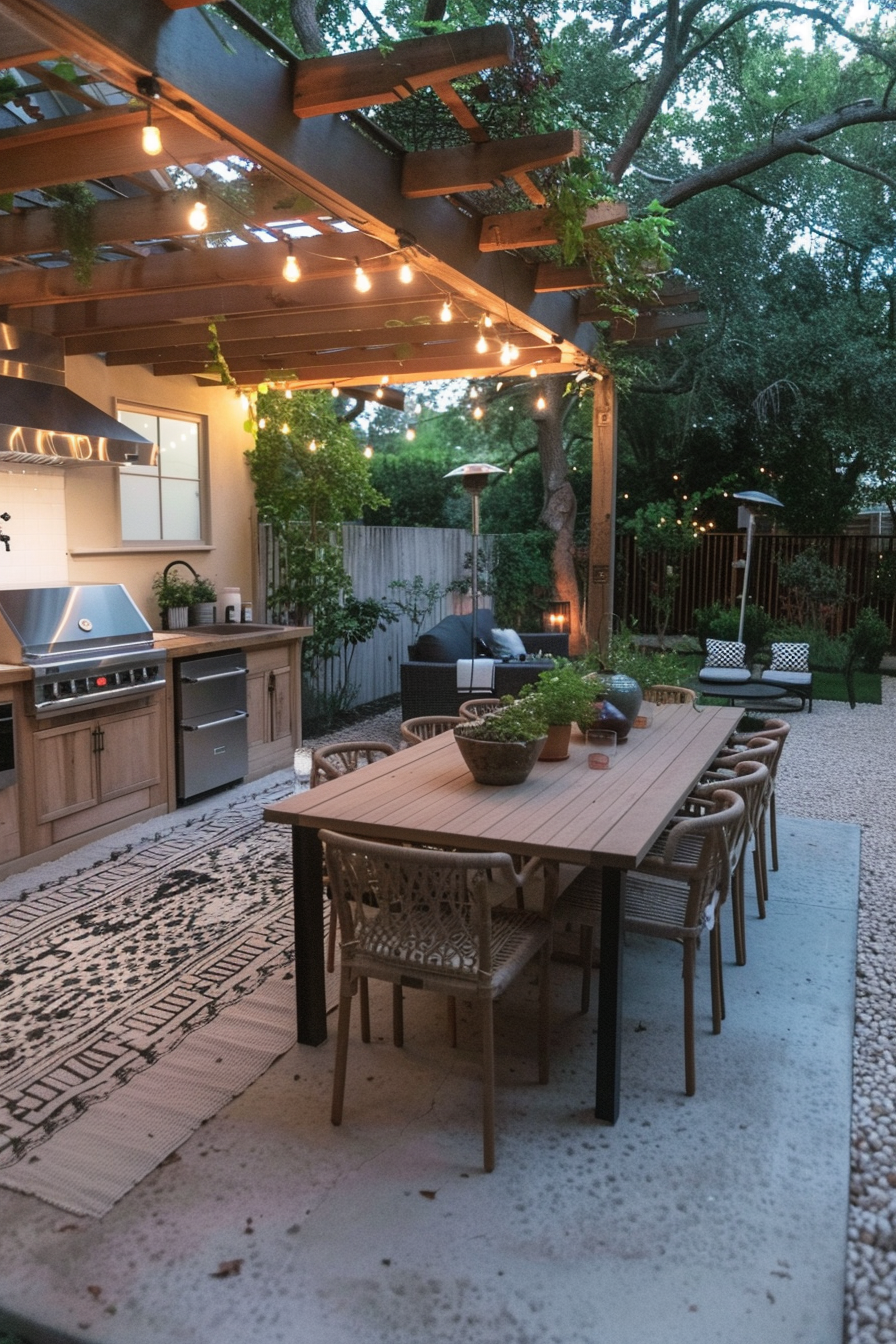
11. Use Pavers for Elegant Pathways
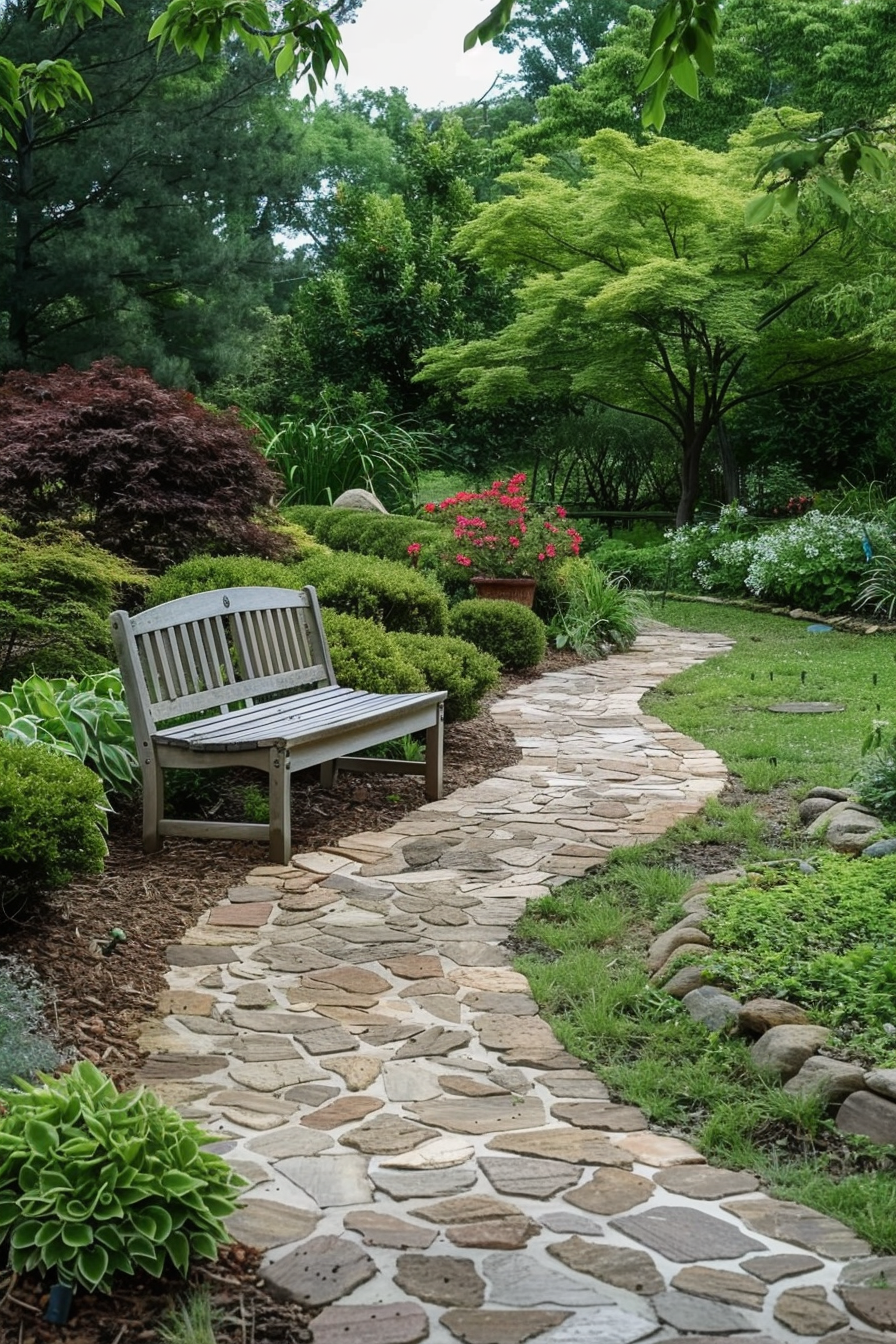
Pathways are more than just functional elements in a backyard—they can be elegant features that enhance the overall design. Using pavers or stepping stones, you can create beautiful, durable paths that guide visitors through your garden. Stone, brick, or concrete pavers are popular choices due to their durability and variety of colors and textures. Choose a material that complements the style of your home and garden for a cohesive look.
The design of the pathway is equally important. Straight paths can create a formal, structured look, while curved or meandering paths add a sense of mystery and natural flow. Consider the scale and layout of your garden when planning the pathway, ensuring it connects key areas such as seating spots, garden beds, or water features. Adding edging or borders made from bricks, stones, or plants can help define the path and keep it looking neat.
Enhancing your pathways with lighting can make them both safer and more attractive. Solar-powered lights along the edges can illuminate the way without requiring complicated wiring. Low-level lights embedded into the pavers or lanterns placed at intervals add a charming glow that enhances the evening ambiance. By thoughtfully designing and integrating pathways, you can elevate the functionality and beauty of your backyard.
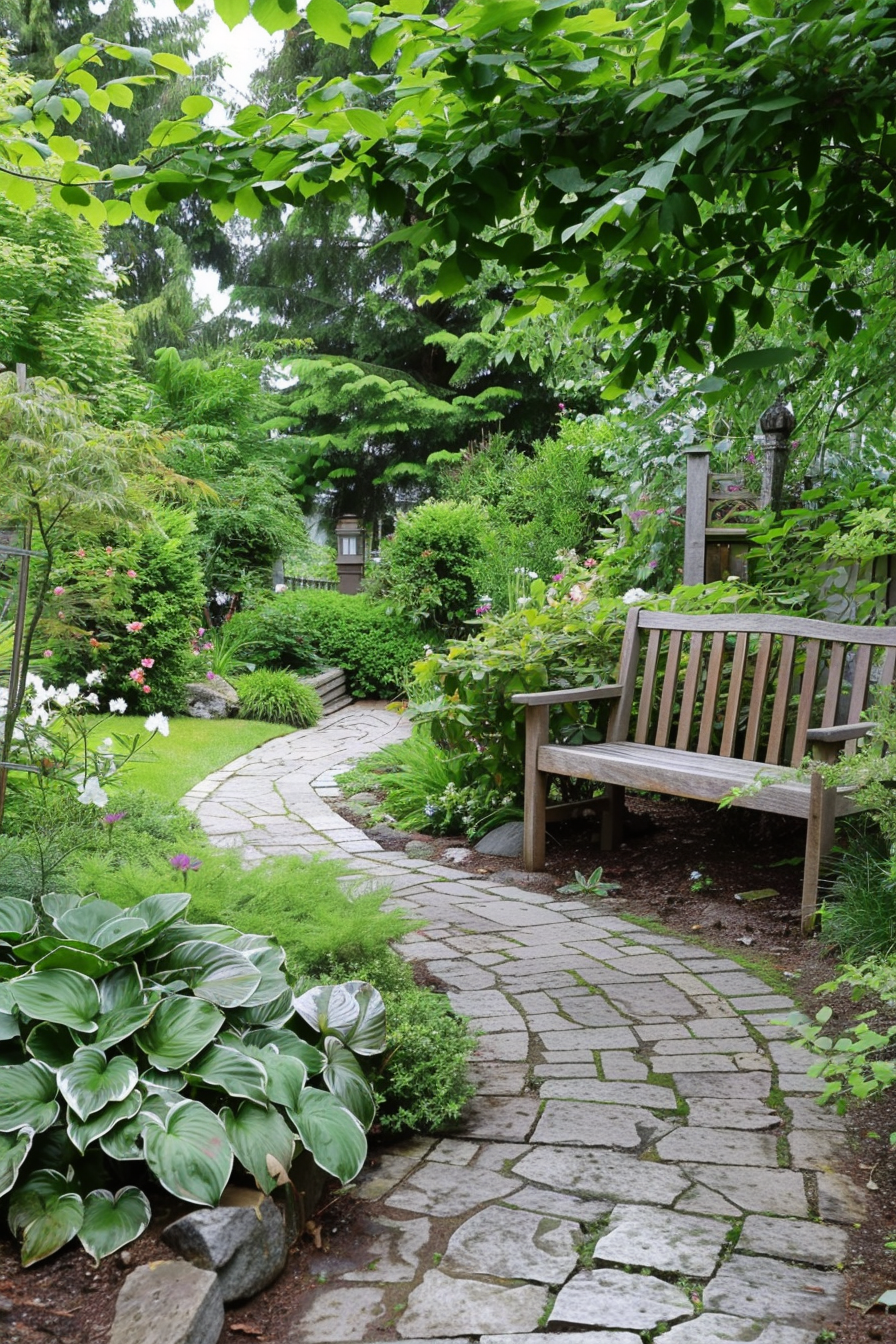
12. Add a Garden Arch or Trellis
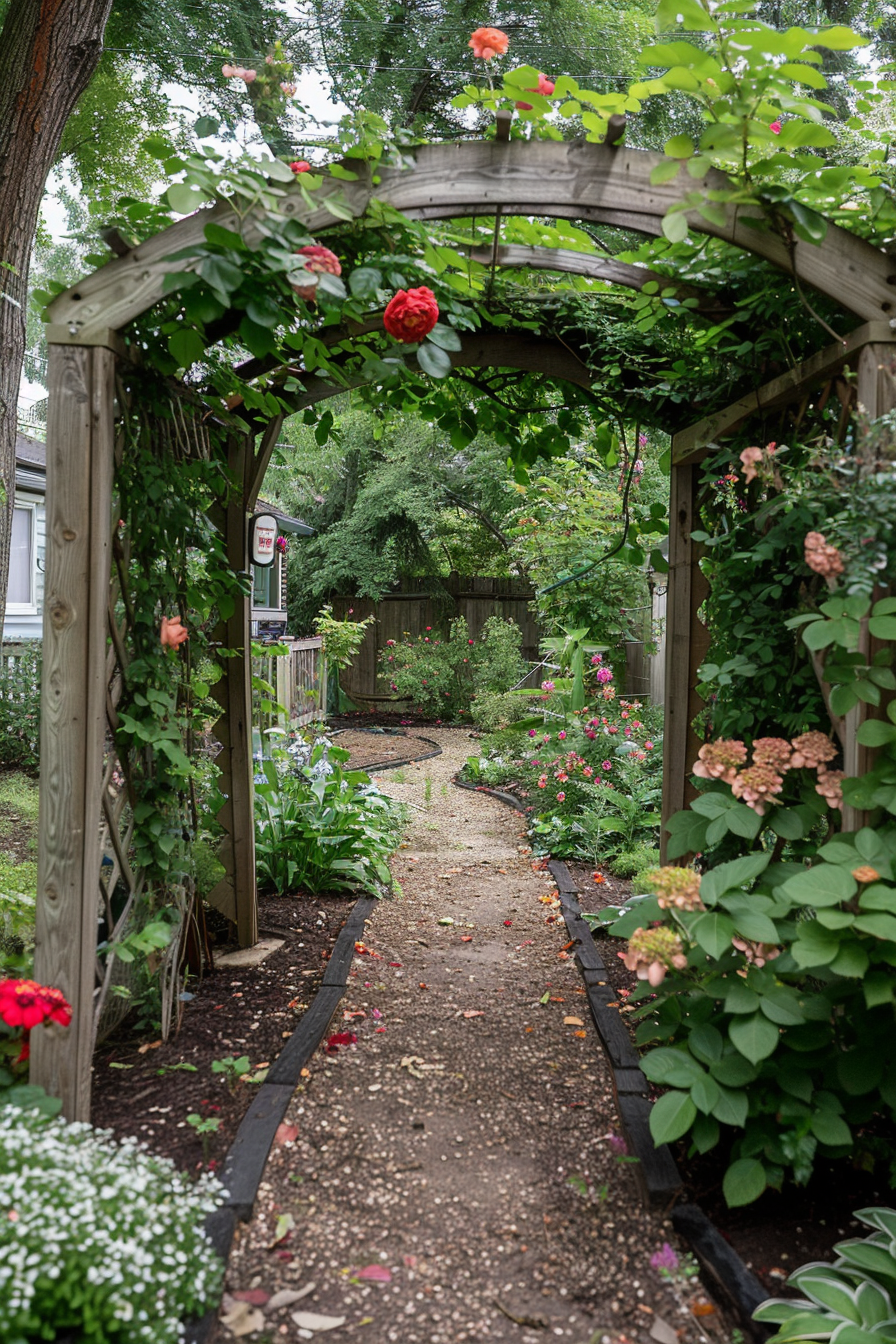
A garden arch or trellis can add a vertical element to your backyard, serving as both a focal point and a support for climbing plants. These structures come in various designs and materials, from simple wooden arches to ornate metal trellises. Placing an arch at the entrance of a garden or along a pathway can create a welcoming and romantic ambiance.
Climbing plants like roses, ivy, or wisteria can transform a plain arch or trellis into a stunning, living feature. As these plants grow and bloom, they create a natural canopy that offers shade and a burst of color. The intertwining vines and flowers soften the structure and blend it seamlessly into the surrounding garden. For a more dramatic effect, consider using fragrant flowers that will fill the air with their scent as you walk beneath them.
Beyond aesthetics, a trellis can also serve practical purposes. It can provide privacy by screening off certain areas or act as a windbreak in exposed gardens. When placed strategically, these structures can guide the eye to different parts of the garden, adding depth and interest to the landscape. Whether used as a decorative feature or for functional purposes, a garden arch or trellis can enhance the charm and beauty of your backyard.
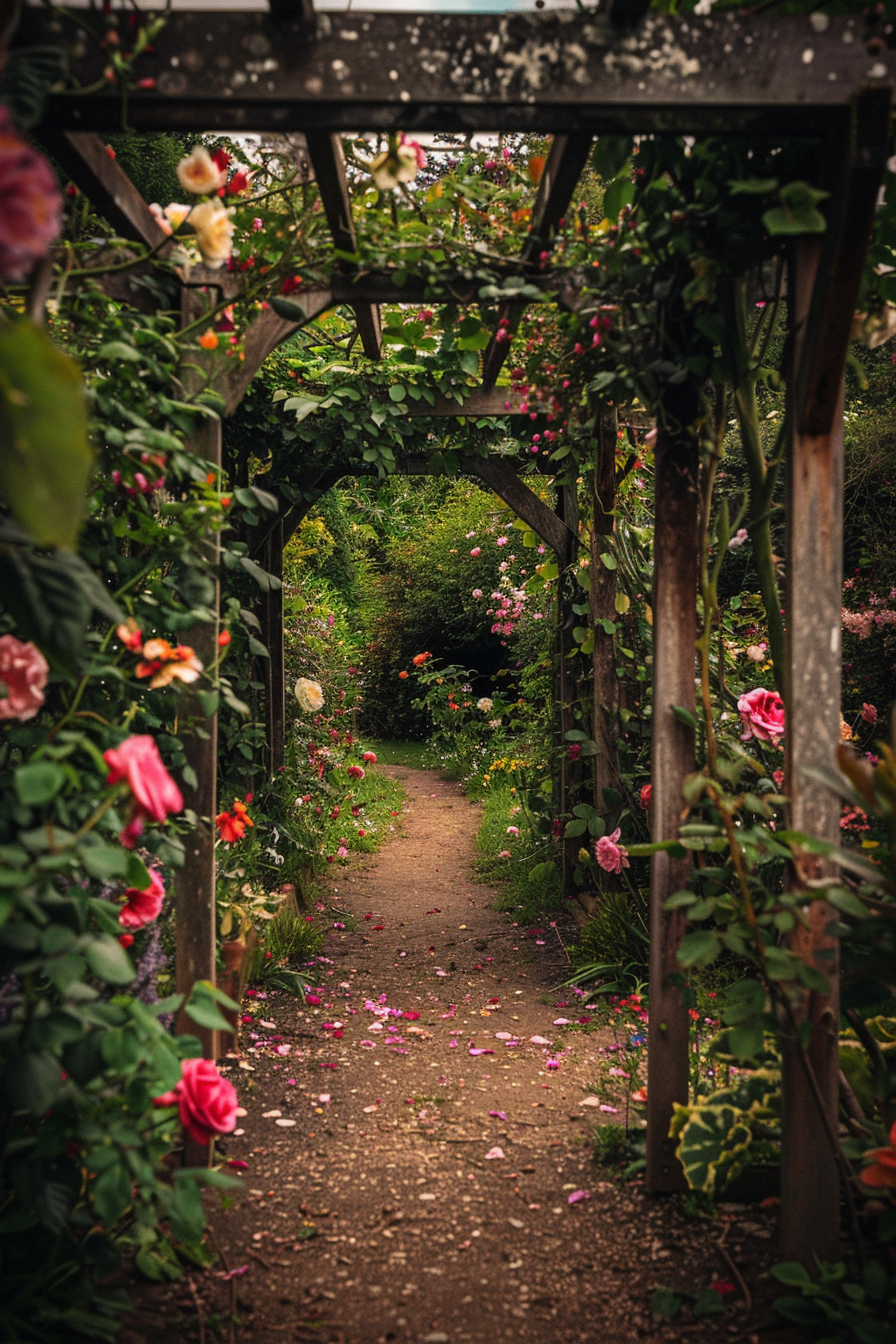
13. Create a Relaxing Zen Garden
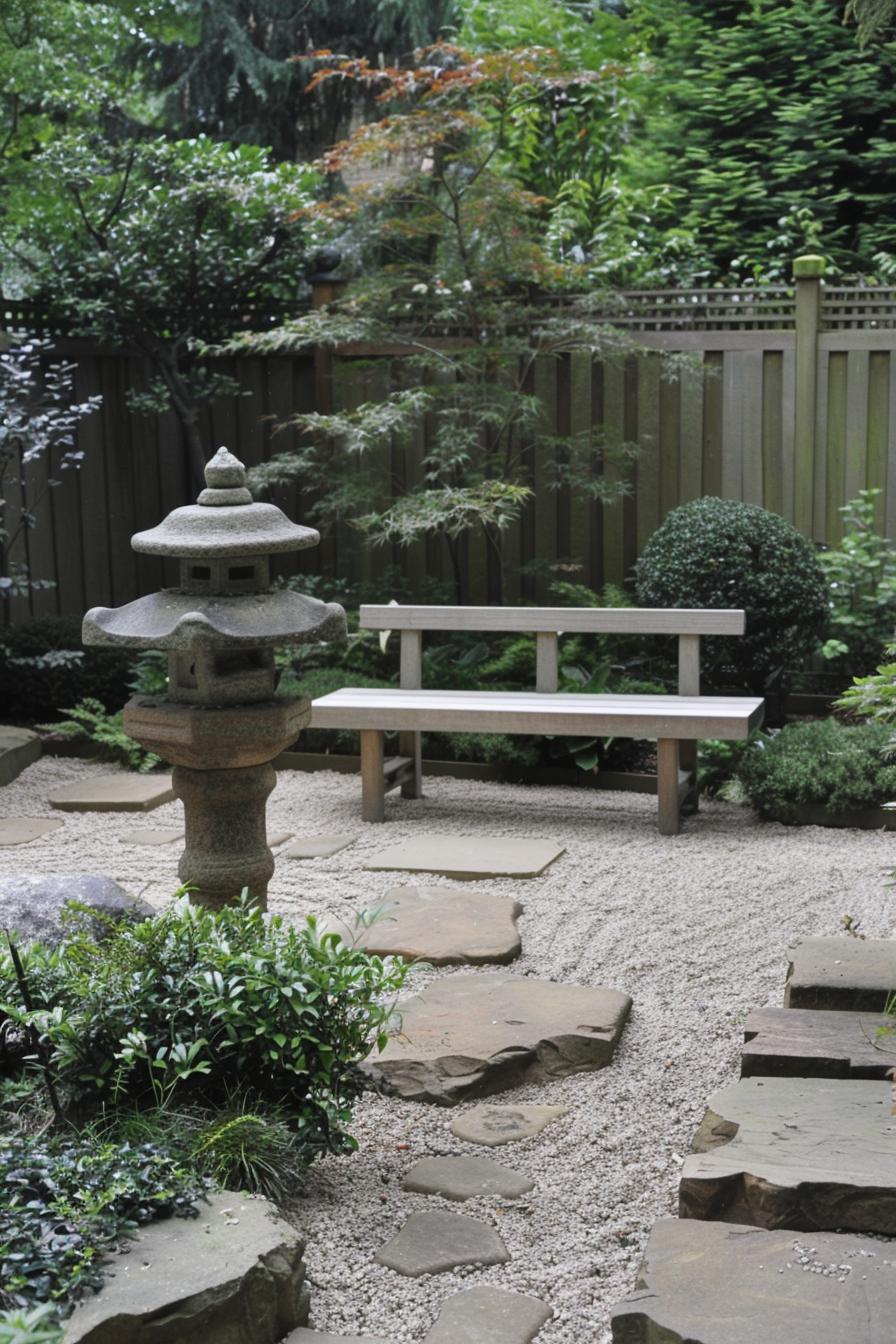
A Zen garden can be a perfect addition to a backyard, offering a tranquil space for relaxation and reflection. Originating from Japanese culture, Zen gardens typically feature elements like sand, rocks, and carefully selected plants arranged in a minimalist, harmonious layout. The sand or gravel represents water and is often raked into patterns to simulate waves or ripples. This aspect of Zen gardening can be meditative, providing a soothing activity that enhances the sense of calm.
Rocks and stones play a significant role in Zen gardens, symbolizing mountains or islands. These elements can be arranged to create visual interest and balance within the garden. Choose rocks of different shapes and sizes to add variety, and place them thoughtfully to maintain the serene and orderly appearance typical of Zen design. Adding a stone lantern or a small Buddha statue can further enhance the peaceful atmosphere.
Plant selection in a Zen garden is typically understated and focused on greenery rather than colorful flowers. Moss, bamboo, and ferns are popular choices, as they contribute to the garden’s tranquil and natural look. A small water feature, such as a bamboo fountain or a simple basin, can introduce the soothing sound of flowing water. By integrating these elements, you can create a Zen garden that serves as a peaceful retreat from the hustle and bustle of daily life.
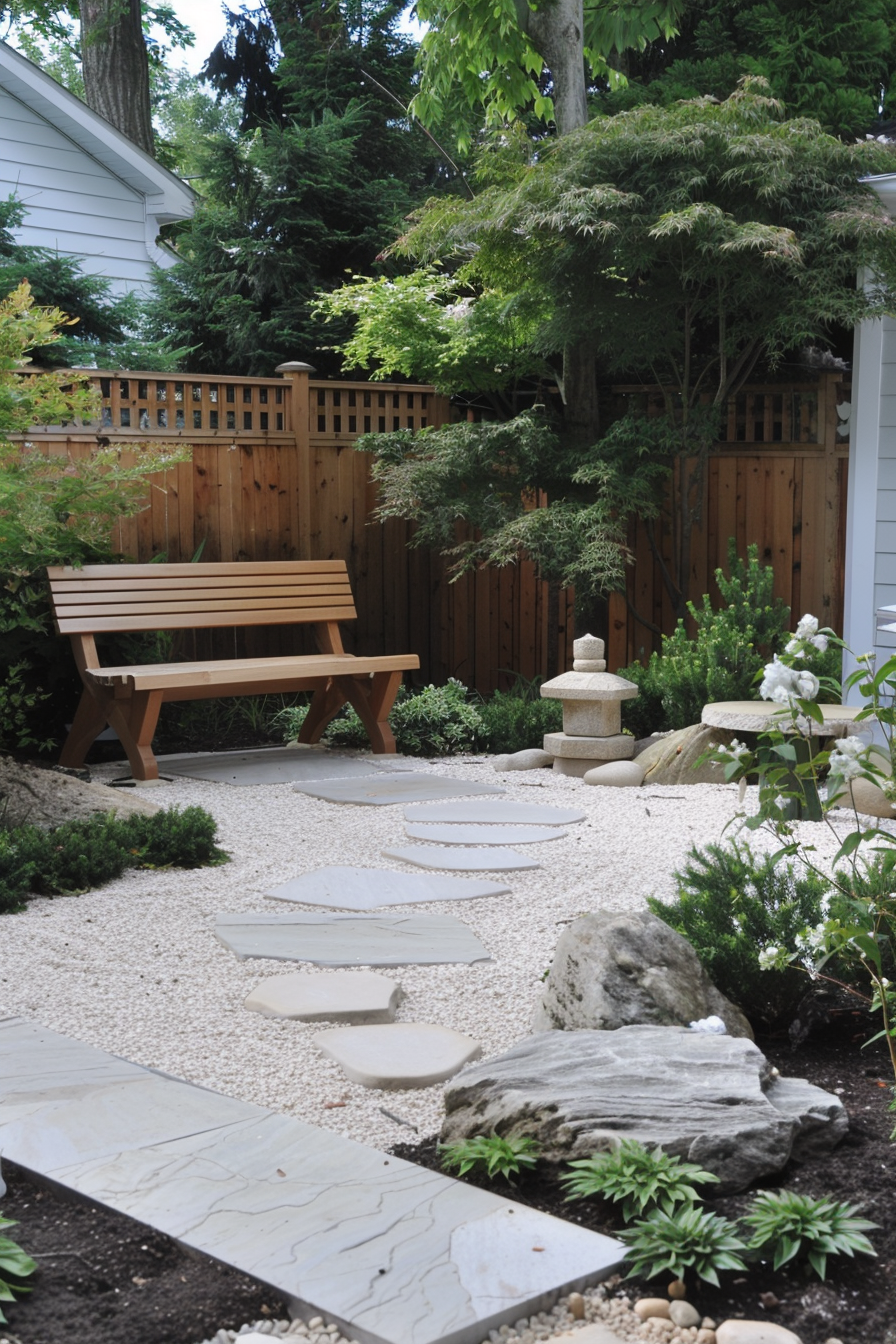
14. Incorporate a Play Area for Kids
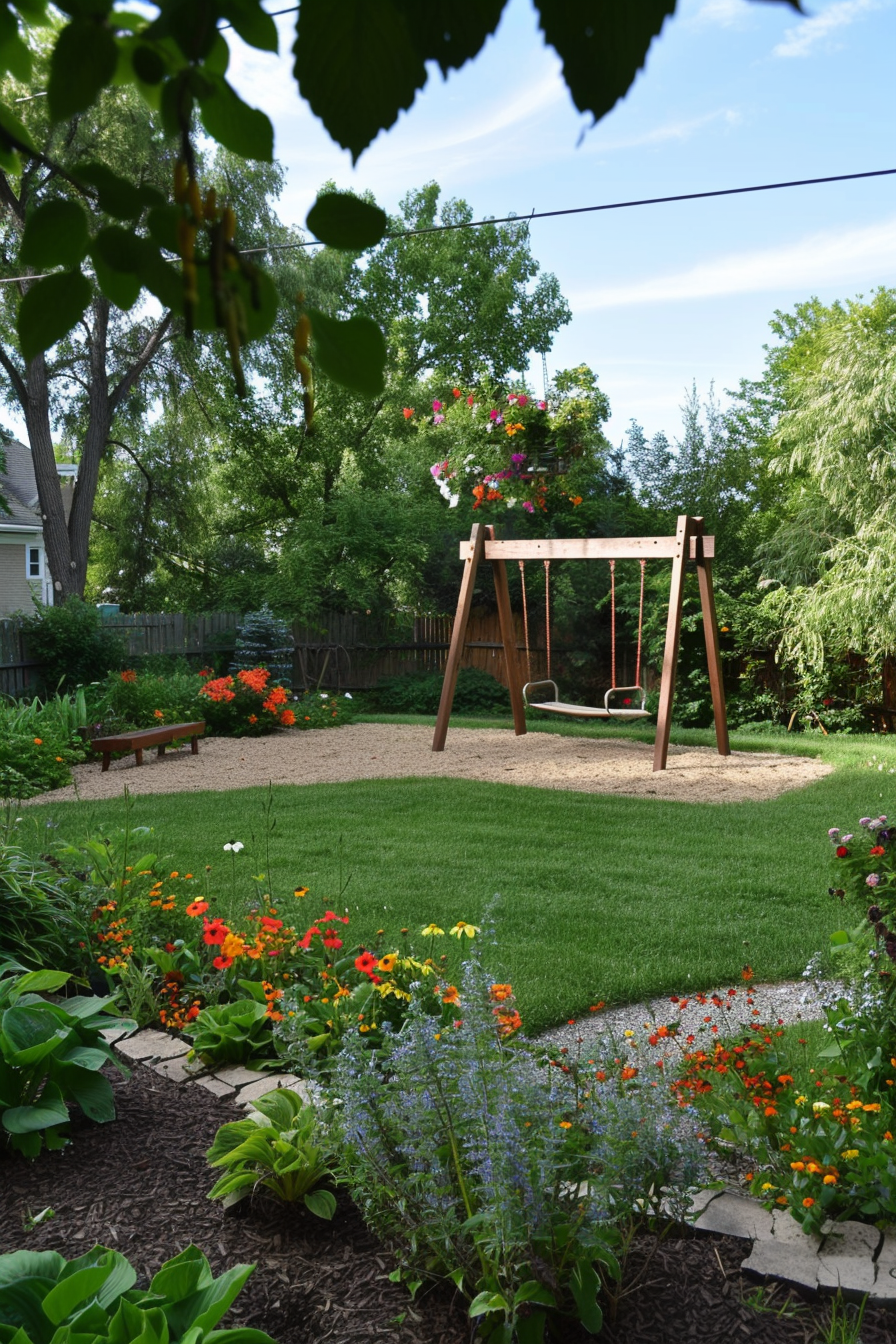
For families with children, a dedicated play area in the backyard can provide endless fun and a safe place for kids to explore. Start by selecting a location that is visible from the house, so you can keep an eye on the kids while they play. Include a variety of play equipment that caters to different interests and age groups, such as a swing set, sandbox, or playhouse.
Safety should be a top priority when designing the play area. Use soft, impact-absorbing materials like rubber mulch or grass under and around play equipment to cushion falls. Ensure that all structures are securely anchored and free of sharp edges or small parts that could pose a hazard. Bright colors and whimsical designs can make the play area visually appealing and inviting for children.
In addition to the equipment, consider adding features that encourage creativity and nature play. A small garden bed where kids can plant flowers or vegetables, a water table for sensory play, or a designated area for arts and crafts can provide hours of entertainment. By incorporating a play area into your backyard, you create a fun and engaging environment where kids can enjoy the outdoors and let their imaginations run wild.
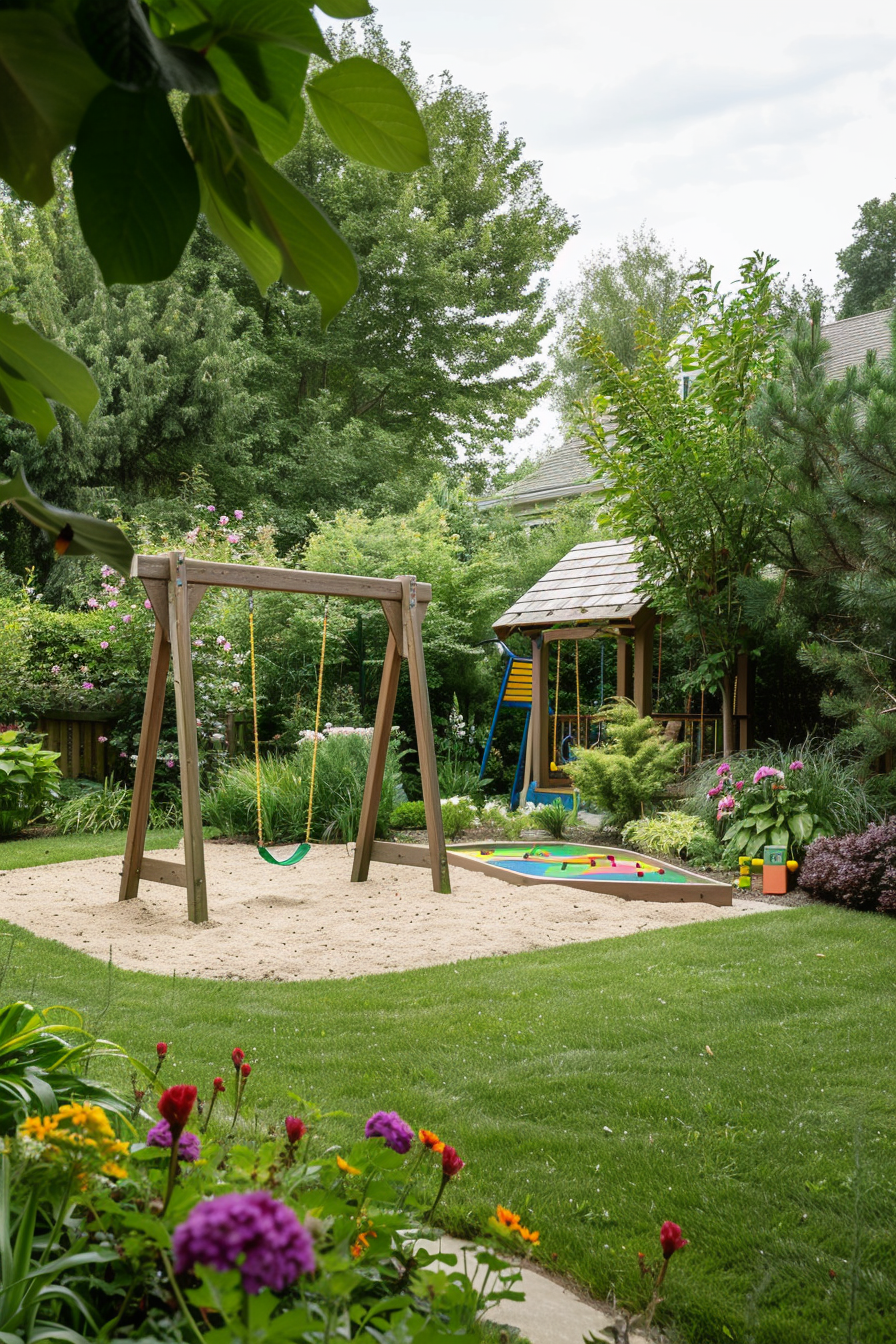
15. Light Up the Night with Outdoor Lighting
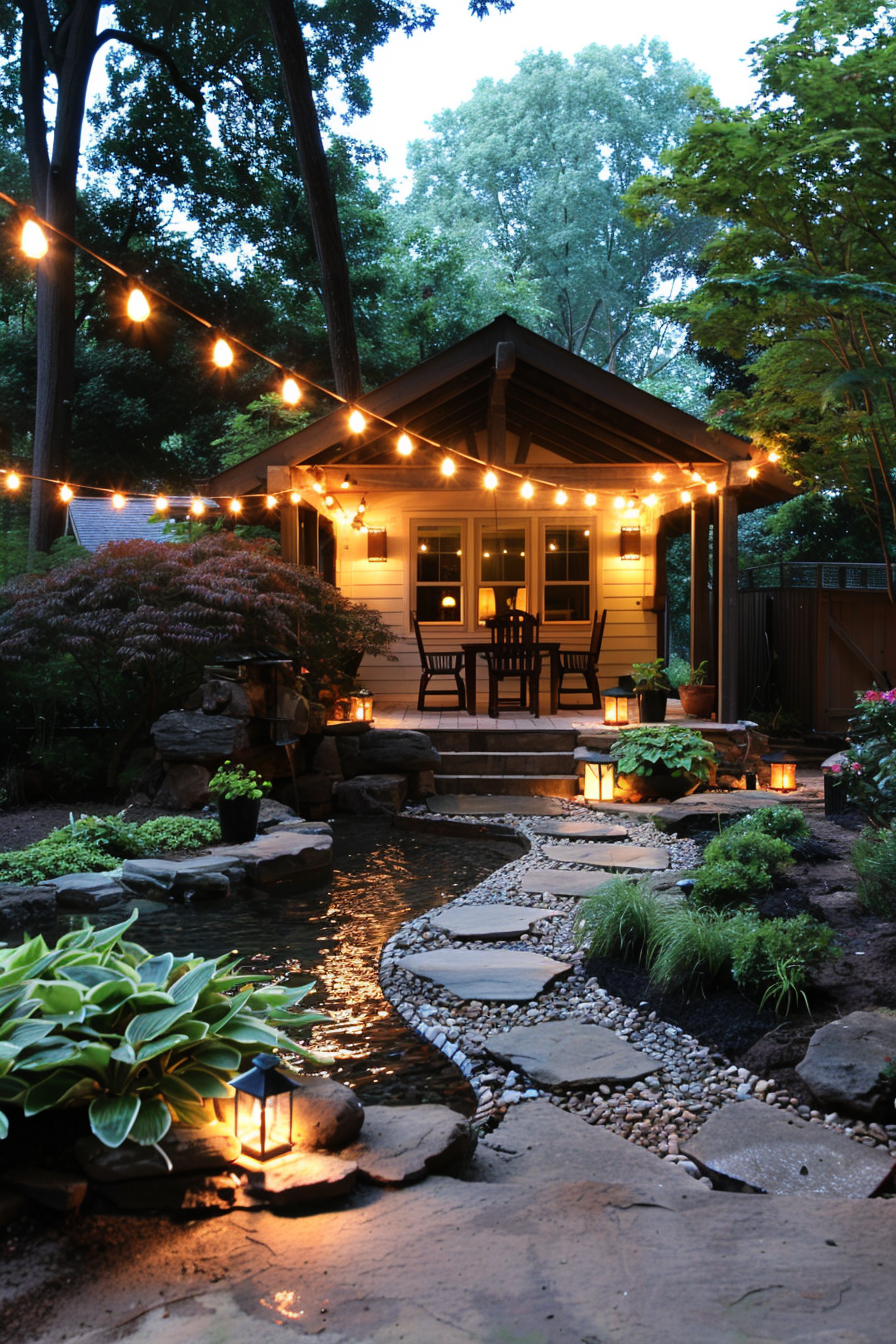
Outdoor lighting is an essential element for extending the usability and enhancing the ambiance of your backyard after dark. Start by installing basic functional lighting along pathways and near steps to ensure safety. Solar-powered lights are a convenient option, as they are easy to install and operate without the need for electrical wiring. Place these lights at regular intervals to illuminate the way and prevent accidents.
Beyond functionality, lighting can also be used to create a magical, inviting atmosphere. String lights hung across a patio or pergola can mimic the look of stars and add a festive touch to evening gatherings. Lanterns or candlelit holders placed on tables or around seating areas provide a warm, intimate glow. Up-lighting or spotlights can highlight specific features in your garden, such as trees, sculptures, or water elements, casting dramatic shadows and enhancing the visual interest of your landscape.
Consider using different types of lighting to create layers and add depth to your outdoor space. Combining ambient, task, and accent lighting allows you to highlight various aspects of your backyard and create a cohesive, well-lit environment. Whether you’re hosting a party, enjoying a quiet evening outdoors, or simply want to appreciate your garden at night, well-placed outdoor lighting can transform your backyard into a welcoming retreat after the sun sets.
